|
 “BOTTLES AND KEGS” “BOTTLES AND KEGS”
A HISTORY OF SODA AND BEER BOTTLING
IN
A SOUTHERN SEAPORT TOWN
DURING
THE NINETEENTH CENTURY
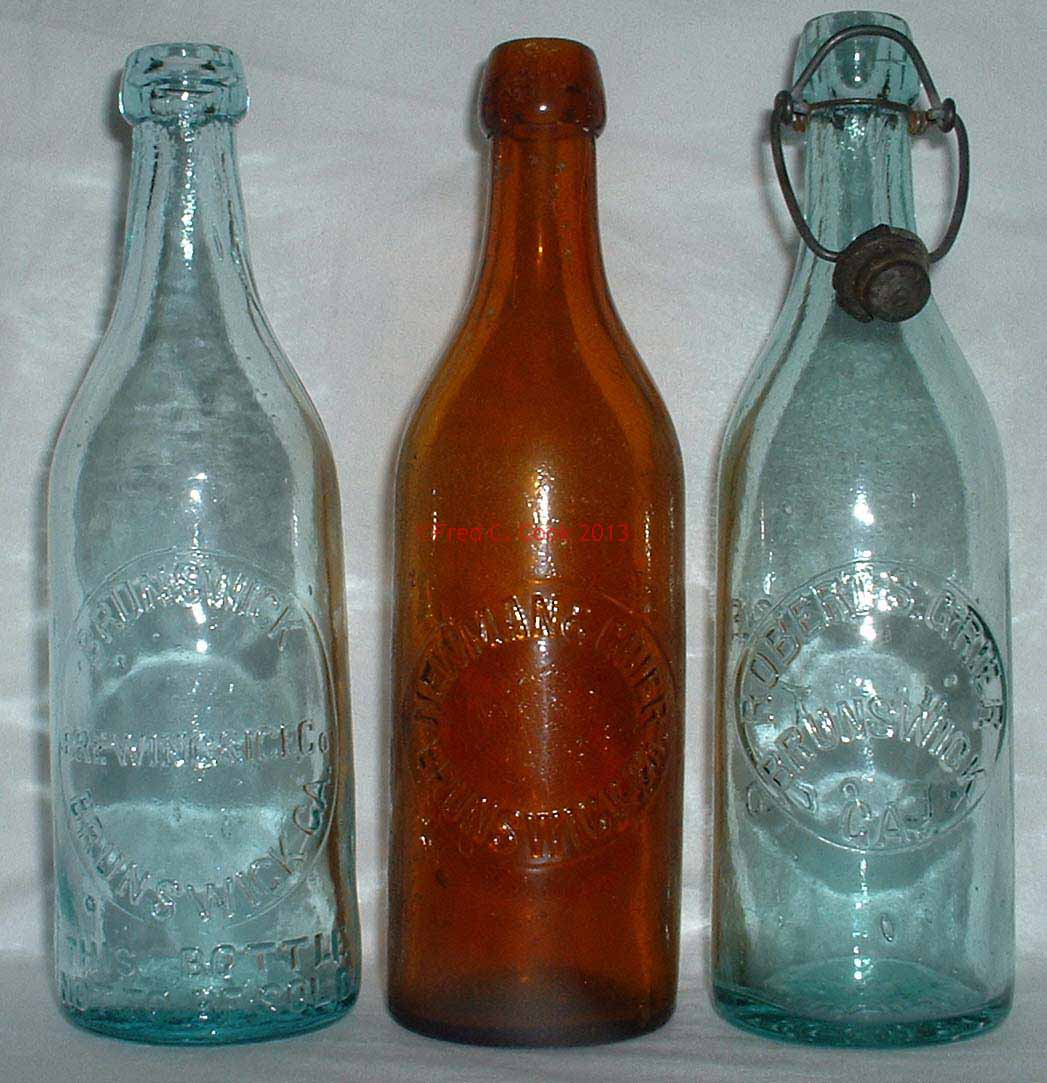
by
Fred C. Cook
All Rights Reserved © 2012
|

i
Strawberry Soda water and draft beer were two of
the beverages bottled in Brunswick, Georgia in the nineteenth
century. Shown above are the original bottles used by
Oglethorpe Bottling Works and Robert S. Grier in the
1880’s. The contents are modern.
i |
|
ii
FORWARD
This book was written for those people who share my interest in
small scale nineteenth century soda and beer bottling. Inspired by
this subject, I gathered information from historic maps, newspapers,
city directories, U. S. Census records, U. S. Patents and court
house documents in order to recreate what beverage bottling was like
in Brunswick, Georgia, a small southern seaport. The few excavations
conducted were in connection with the archaeology classes I taught
at McIntosh County Academy in 1998 and 1999. The students
participated in archaeological field work, analyzed the artifacts
and presented their interpretations in triptych public displays.
This book focuses on what I discovered about those early bottler’s
lives and their businesses. Within its more than sixty pages of
content, this book features twenty-one color photographs,
twenty-seven illustrations, twelve historic maps and forty-one line
drawings that depict all known types of soda and beer bottles
embossed with the name of a Brunswick bottler. A bottle rarity guide
is also provided in an appendix.
In the nineteenth century some of Georgia’s cities and towns, such
as Brunswick, had businesses that formulated, mixed and bottled
their own flavors of soda water. The technology that was available
at the time allowed this beverage to be manufactured and bottled on
a small scale. Often, the back room in a grocery store provided
sufficient space for the necessary soda equipment. My maternal
grandmother told me tales of bottling soda at her father’s general
store in West Point, Georgia. Unlike beer that was sterilized by
heat during the brewing process, soda water was sometimes made with
poor quality shallow well water. Furthermore, microbial
contamination could occur during production, bottling and even
storage in bottles whose design allowed dust, dirt and pest filth to
collect in their necks. However crude its method of production may
have been, soda water bottling was a thriving business in Brunswick
by the 1880s.
While soda bottling was getting started in Brunswick, some of the
local saloon and liquor merchants were purchasing beer by the keg
for retail distribution. Most of the beer came from distant
Midwestern brewers, who delivered it directly to Brunswick in
refrigerated rail road cars and, for a few short years, a local
brewery. These kegs were tapped in the merchant’s place of business,
and the contents were sold by the mug or bottled for distribution
throughout the community. These businesses were identified by the
glass bottles that bear the proprietors’ names, Sanborn maps and
Brunswick Directories.
During this same period of time, there were over two thousand
breweries in the United States. However, the largest Midwestern
breweries had begun to edge many of their small competitors out of
the market. Companies such as Pabst, Anheuser Busch and Schlitz used
methods that were the brewer’s equivalent of mass-production.
Furthermore, the newly implemented process of pasteurization helped
extend the shelf life of bottled beer, making storage and
transportation to distant markets feasible. These large breweries
were able to produce and market palatable beers that were consistent
in quality. In contrast to their Midwestern counterparts, many of
the small scale southern breweries used techniques that favored
using numerous small batches in order to achieve the
ii |
|
iii
volume of production they desired. Needless to
say, their beers were far less uniform than those produced by their
Midwestern competitors. For a brief period of time, Brunswick was
the home of such a brewery. Its advertised annual 50,000 barrel
production, a volume they probably never achieved, was only
one-twentieth of the capacity of the contemporary Pabst brewery in
Milwaukee. A detailed historic map and a document found in the Glynn
County Courthouse provided a wealth of information about this small
town brewery.
Today there is a growing interest in embossed nineteenth century
soda and beer bottles. The main reason for this interest is the fact
that these bottles were manufactured by one of the last American
industries to produce hand crafted items employing artisan-like
skills. Furthermore, in the vast majority of cases, glass bottles
are the only surviving tangible remains of the businesses they
represented.
The viewer should be aware that the CD version of this book provides
two important features. The first is the “go to” button under
“edit.” This provides an easy way to navigate from one page to
another. The second feature is the “zoom” window in the tool bar.
This allows photographs and illustrations to be viewed at higher
magnification. All of these should be viewed at 150-200%.
The primary sources of information used for this book were:
Newspapers:
Brunswick Daily Advertiser and Appeal (March, 1875-November,
1889)
Brunswick Times Advertiser (January, 1894-November, 1896)
Brunswick Call (May, 1896-March, 1901)
City Directories:
Brunswick City Directory (1890)
Howard’s Directory of Brunswick, Darien, St Simon and St. Mary’s
(1892)
Vance’s Brunswick and St Simon Consolidated Business and
Partnership Directory (1896)
Due to the length of the directory titles they are referenced in the
text with the generic term “Brunswick city directory.”
Maps:
Brunswick, Georgia Sanborn Map and Publishing Co. April, 1885
Brunswick, Georgia Sanborn Map & Publishing Co. Limited May, 1889
Brunswick, Georgia Glynn Co. Sanborn-Perris Map Co. Limited April,
1893
Brunswick, Georgia Glynn Co. Sanborn-Perris map Co. Limited July,
1898
Columbus, Georgia Sanborn Map & Publishing Co. February, 1885
Columbus, Georgia and Environs Sanborn-Perris Map Co. Limited Sept
1895
Due to the length of the map titles they are referenced in the text
with the generic term “Sanborn map.”
F.C.C. 2012
iii |
|
TABLE OF CONTENTS
FRONTISPIECE: Oglethorpe Bottling Works and
Robert S. Grier
Bottles……………………………………..............................................………………………………..
ii
FORWARD.…………………………..............................................……………………………………
iii
CHAPTER ONE: Brunswick, Georgia, Early History
and the Roots of Its Bottling Industry..............1
CHAPTER TWO: The History and Technology of Soda
Water and Beer.............................................4
Part
One-Soda....................................................................................
4
Part Two- Beer……………………………………………………...
8
Part Three- Bottles………………………………………………….
10
CHAPTER THREE: Brunswick’s Nineteenth Century
Soda Bottlers...................................................16
Brunswick Bottling Works…………………………………………
16
Oglethorpe Bottling Works…………………………………………
16
Brunswick Brewing & Ice Company………………………………..
20
T. B. Ferguson……………………………………………………..
21
C. O. Marlin & Company…………………………………………..
31
William B. Gunby…………………………………………………...
32
Acme Bottling Works……………………………………………….
32
L. Markowitz……………………………………………………….
32
CHAPTER FOUR: Brunswick’s Early Twentieth Century
Soda Bottlers..............................................36
Louis Ludwig……………………………………………………….
36
Cline & Ludwig…………………………………………………….
36
Brunswick Bottling & Manufacturing Company…………………......
37
Brunswick Coca-Cola Company………………………………...…
38
CHAPTER FIVE: Brunswick’s Nineteenth Century Beer
Bottlers….....................................................39
Benjamin Hirsch……………………………………………………..
39
Robert S. Grier………………………………………………………
43
Newman & Grier…………………………………………………….
46
Tobias Newman……………………………………………………...
47
Charles Freund Agt…………………………………………………..
53
Brunswick Brewing & Ice Company……………………………….…
54
Appendix 1- Bottle Rarity
Guide……………...............................................……………………………
65
iv |
|
pg. 1
CHAPTER ONE—BRUNSWICK,
GEORGIA, EARLY HISTORY AND THE ROOTS OF ITS BOTTLING INDUSTRY

The harbor town of Brunswick, Georgia in 1857.
The town of Brunswick was established in the
eighteenth century as a small sea port on the southern Georgia
Coast. Its location on the western side of a flat forested
peninsula provided its harbored vessels with excellent protection
from storms. In its recorded history, Brunswick has
experienced only one hurricane causing major damage.
pg. 1 |
|
pg. 2
The Brunswick peninsula was first inhabited by prehistoric Indians,
who occupied the area intermittently from about 8,000 B. C. until
the sixteenth century. The Native Americans were attracted to
the peninsula by the prolific acorn crops of its Live Oak forests
and ideal access to Turtle River and its tributaries. These
waters provided, in abundance, the fish, oysters and clams that were
also important to the Indians’ diet. Archaeological surveys of
the Brunswick peninsula indicate that the main Indian occupation
occurred there between 600 and 1400 A. D. By the middle 1500s,
the Native Americans of coastal Georgia were suffering from European
born diseases and subjugation. Indians in the Brunswick area
responded to these conditions by withdrawing to mission sites on
Cumberland Island. There is no evidence to indicate that the
Brunswick peninsula was occupied for the next two hundred years.
Then, after almost two centuries of abandonment, the area was
repopulated in the 1730s by the famous settler Mark Carr
and his family. Carr, who had his principal plantation
on the Brunswick peninsula, helped General James
Oglethorpe fend off Spanish attacks launched from northeast
Florida.
The town of Brunswick was formally founded in 1771 and it grew
slowly for the next one half century. By the second quarter of
the nineteenth century, Brunswick was enjoying a period of
prosperity. However, the economic depression of 1839
terminated its growth for over a decade. About 1850 another
period of economic prosperity began. This new period of
economic success was based on shipping commerce, which continued to
increase for another decade. Brunswick became more populous
during this time and it was incorporated in 1856. James
T. Lloyd’s Railroad Map of the Southeastern States shows that
Brunswick had a railroad line by at least 1862.
Because of it’s proximity to the Federal blockading fleet and the
Union troops that occupied nearby St. Simons Island, Brunswick’s
inhabitants fled to the interior during the early stages of the
Civil War. When the citizens returned in 1865, they found the
town dilapidated, but otherwise intact. Aided by northern
entrepreneurs, Brunswick’s citizens immediately began a period of
rebuilding. The economic success that followed was based
largely on the lumber and naval stores industries. The
northern entrepreneurs that had moved to Brunswick in the decade
following the Civil War provided the money and jobs that were needed
for the town’s economic revitalization. For example, my
great-grandfather, John R. Cook, moved south from
Massachusetts with his younger brother in 1866 and chartered a
lumber business on the Brunswick waterfront. John and
George Cook chose Brunswick as a place to establish
their lumber business for several apparent reasons. First,
Brunswick was conveniently close to the vast stands of virgin yellow
pine that sprawled across millions of acres of the coastal plain.
Secondly, unlike Darien, its sister city to the north, Brunswick had
suffered few reprisals from Union troops during the war.
Consequently, the animosity felt by many southerners toward the
North at the close of the war was not strong in Brunswick.
With many of its homes and businesses intact, Brunswick was
physically prepared to resume normal activity in 1866.
Brunswick’s citizens were eager for employment and they welcomed
northern entrepreneurs with open arms. By 1870, so many
northern businessmen lived on Union Street that the native residents
called the area “Yankee Ville.” In 1885 the population of
Brunswick was 5,000. However, four years later the population
had skyrocketed to 9,800. Local newspapers documented the
town’s growth with a variety of articles and short business clips.
Foremost in the business increase, were immense shipments of sawn
pg. 2 |
|
pg. 3
timber. For example, during the months of
May and June 1877 over 2,000,000 board feet of lumber were shipped
from Cook Brothers & Company alone. The good economy with its
positive cash flow created a new consumer market, which resulted in
a variety of small retail businesses sprouting up all over town.
The people that worked in Brunswick could afford luxuries unheard of
in previous years. Included in the list of newly affordable
goods were cold beverages that quenched a worker’s thirst during and
after a hard day’s work in the hot southern sun. In the early
1880’s local newspapers carried advertisements for “ice cold soda
water” sold “by the glass” at local drug stores. However, the
consumption habits of people were changing. Soda water and
beer, which had previously been drawn into a glass or mug, were
being taken home in bottles. Savannah bottlers, such as
James Ray, Henry Kuck, Henry Lubs,
and John Ryan actively competed for the Brunswick
market in the 1870s and 1880s (see page 64). Unfortunately for
them, their beverages came in return bottles which bore the cost of
two way shipment. By the middle 1880s the expense of supplying
a town 70 miles away was too much for the Savannah bottlers to bear.
Their withdrawal from the beverage market created an incentive for
local bottling companies to appear.
pg. 3 |
|
pg. 4
CHAPTER TWO—THE
HISTORY AND TECHNOLOGY OF SODA WATER AND BEER
PART ONE—SODA
WATER
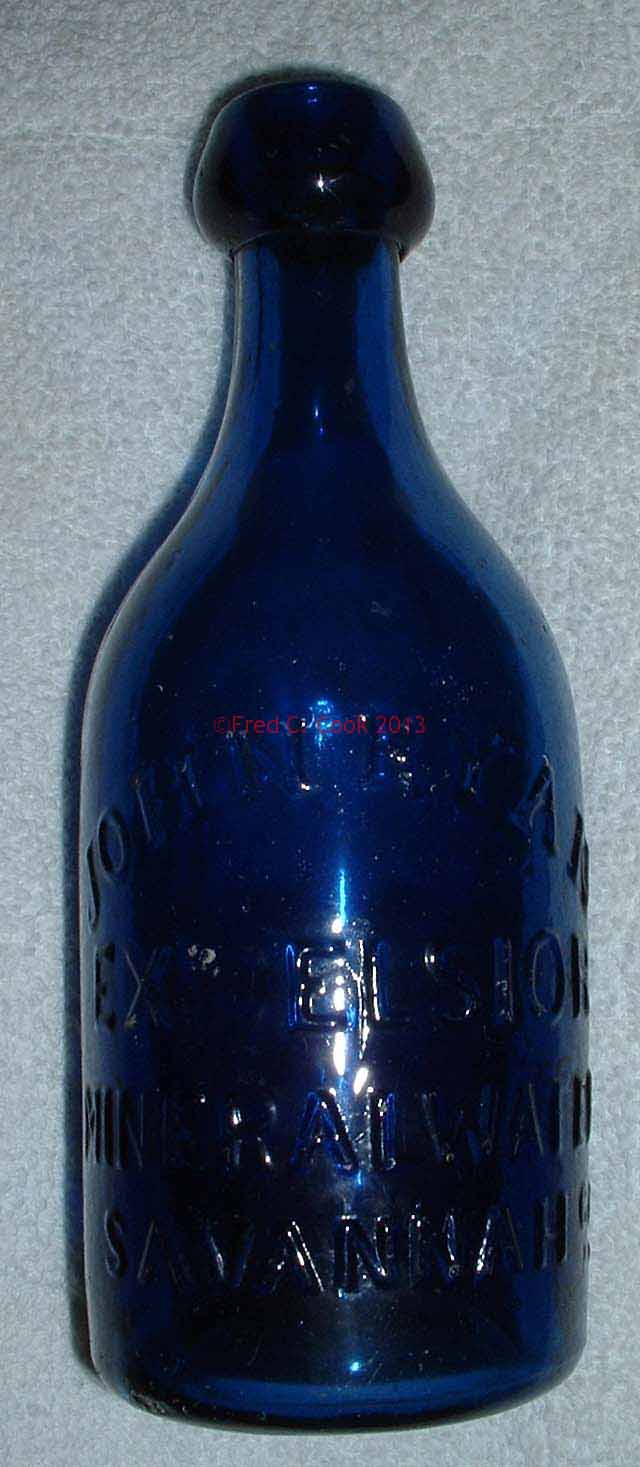 In the early nineteenth century soda water was only one of many
different varieties of naturally occurring spring water known as
“mineral water.” Coming from freely flowing springs, mineral
waters contained small amounts of various mineral compounds, such as
Magnesium, lithium, and potassium chlorides, hydrogen sulfide
(sulfur), and carbon dioxide that gave them a distinctive taste.
It was commonly believed that most types of mineral water had the
ability to impart good health when consumed or bathed in.
Springs in different locations had different chemical compositions
and presumably, different health benefits. By the 1820’s many
of the major springs, particularly those
In the early nineteenth century soda water was only one of many
different varieties of naturally occurring spring water known as
“mineral water.” Coming from freely flowing springs, mineral
waters contained small amounts of various mineral compounds, such as
Magnesium, lithium, and potassium chlorides, hydrogen sulfide
(sulfur), and carbon dioxide that gave them a distinctive taste.
It was commonly believed that most types of mineral water had the
ability to impart good health when consumed or bathed in.
Springs in different locations had different chemical compositions
and presumably, different health benefits. By the 1820’s many
of the major springs, particularly those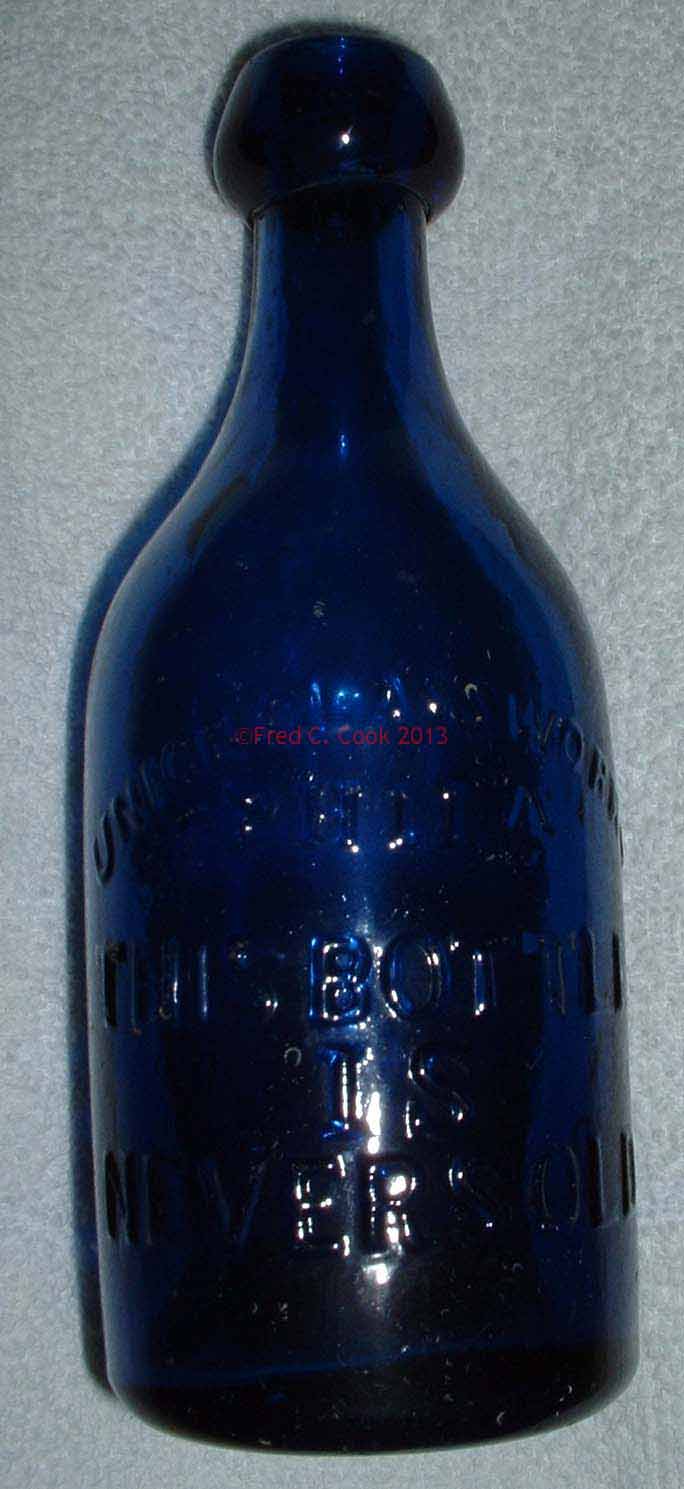 around Saratoga, New York, had been commercialized with the
construction of bathing facilities and hotels. With an eager
eye for business, owners began bottling their spring water and
shipping it to distant locations. Probably, the most popular
water was that bottled at the Congress Spring in New York.
Congress Spring water bottles are found throughout the eastern
United States. Beyond its purported healthy qualities, spring
water containing carbon dioxide was especially tasty when small
amounts of fruit juice or other flavorings were added to it.
So great was the demand for this modified “mineral water” that
southern entrepreneurs began to manufacture it from ordinary well
water. This was accomplished by dissolving artificially
produced carbon dioxide gas in cool water. The concentration
of carbon dioxide in the artificial “mineral water” could be much
greater than in the natural variety. In the artificial mineral
water, the gas would fizz quickly out of solution unless it was
sealed under pressure in a bottle. The fact that traditional
glass bottles would burst from the increased pressure, led to the
development of smaller glass bottles with thicker walls. In
the two decades before the civil war, “mineral waters,” particularly
the “carbonic” (carbon dioxide) type, became increasingly popular
and all major cities in the eastern United States had “mineral
water” bottlers. These bottlers often advertised their product
with colorful bottles embossed with their name.
around Saratoga, New York, had been commercialized with the
construction of bathing facilities and hotels. With an eager
eye for business, owners began bottling their spring water and
shipping it to distant locations. Probably, the most popular
water was that bottled at the Congress Spring in New York.
Congress Spring water bottles are found throughout the eastern
United States. Beyond its purported healthy qualities, spring
water containing carbon dioxide was especially tasty when small
amounts of fruit juice or other flavorings were added to it.
So great was the demand for this modified “mineral water” that
southern entrepreneurs began to manufacture it from ordinary well
water. This was accomplished by dissolving artificially
produced carbon dioxide gas in cool water. The concentration
of carbon dioxide in the artificial “mineral water” could be much
greater than in the natural variety. In the artificial mineral
water, the gas would fizz quickly out of solution unless it was
sealed under pressure in a bottle. The fact that traditional
glass bottles would burst from the increased pressure, led to the
development of smaller glass bottles with thicker walls. In
the two decades before the civil war, “mineral waters,” particularly
the “carbonic” (carbon dioxide) type, became increasingly popular
and all major cities in the eastern United States had “mineral
water” bottlers. These bottlers often advertised their product
with colorful bottles embossed with their name.
pg. 4 |
|
pg. 5
Shown on the preceding page is a cobalt blue
“JOHN RYAN EXCELSIOR MINERAL WATER” bottle from nearby Savannah,
Georgia, that dates to about 1855. The same embossing and a
reminder that “THIS BOTTLE IS NEVER SOLD” provided some degree of
assurance that these relatively expensive bottles would find their
way back to the bottler for refilling.
By the 1850’s, the specific term “soda water” began to replace the
more general term, “mineral water.” The new name was derived
from the chemical process by which carbon dioxide was commonly
manufactured. Today, every school child knows that you can
make a model volcano erupt, that is fizz, by pouring vinegar (a weak
liquid acid) onto baking soda (sodium bicarbonate, a solid source of
carbon dioxide gas) in its central crater. Thus, the term
“soda” in “soda water” is a derivative of the principal element’s
name, “sodium.” So, one way of making soda water is to create
carbon dioxide gas from baking soda and an acid and then force the
gas to flow into cool water where it will dissolve; thus forming
carbonated water. Even on a commercial scale, the production
of carbon dioxide is quite simple. Allow an acid substance to
react with a solid compound containing carbon dioxide (these
compounds are called carbonates). However, a technological
problem arises when certain chemicals are used. For example,
when a cheap strong acid, such as sulfuric acid, is poured onto
sodium bicarbonate or sodium carbonate, the carbon dioxide gas is
evolved in a rapid and uncontrolled way. In a sealed
container, the gas does not have time to dissolve in the water to be
carbonated and a dangerously high pressure results. Early soda
machine inventors were well aware of the fact that excessive
pressure could burst the carbonating vessel.
Patents registered with the United States Patent Office are good
sources of information about devices that were used in the
nineteenth century to produce artificial soda water. They
provide us with a time line of technology that was available to
bottlers. However, in using this information to interpret
nineteenth century technology, one must understand that the time
between the filing of a patent and the actual availability of the
device patented could have ranged from a few months to a number of
years. Also, machines that were cheap and effective could have
remained on the market and/or in use for years or even decades.
The first soda machines were relatively simple, but inherent in most
designs was a way to deal with the problem of rapid gas evolution.
One soda machine, invented by E.D. Wheeler of Murfreesboro,
Tennessee, patented in 1858, considered this problem paramount in
its design (See
illustration below). Wheeler stated
that, “The object of my invention is so to charge the generator with
the substances producing the carbonic acid gas, that the gas shall
be slowly and progressively evolved…” Wheeler further
testified that, “This mode of charging prevents the rapid generation
of gas which takes place under the ordinary method, and thus
relieves the apparatus from the undue pressure of such rapid
generation.” His device, shown below, presumably accomplished
the advertised safe generation of gas by enclosing the charge,
sodium carbonate and tartaric acid (a solid acid that requires water
to react), in a cloth bag (A). The reaction between these two
substances was controlled by the slow absorption of water by the
cloth bag. The carbon dioxide produced by the reaction passed
upward and then down through a pipe (P') into the main body of the
apparatus. The lower part of the pipe had perforations that
were designed to distribute the gas evenly into the water to be
carbonated (F). Wheeler’s patent included directions on
how to modify the generator to use more volatile,
pg. 5 |
|
pg. 6
but less expensive, marble dust (calcium
carbonate) and sulfuric acid (battery acid) as reactants.
Another small, but more complicated, generator was patented by
Hermann Pietsch of Milwaukee, Wisconsin in 1874 (see
illustration below). His device controlled the production of
carbon dioxide by allowing gas pressure to stretch the rubber top of
the generator and simultaneously push the main body of the vessel
(D) downward against a spring. This movement lowered the acid
away from the marble chips (C) upon which it reacted. The
carbon dioxide gas could be drawn off periodically at valve P and
piped to another vessel containing the water to be carbonated.
As the gas was drawn off at valve P, the pressure in the generator
decreased and allowed the spring the move the acid upward where it
would again react with the marble chips. The pressure in the
reactor could be controlled at a safe level by adjusting the
spring’s tension. Vessel W was a scrubber or washer that
removed unwanted acid mist from the gas.

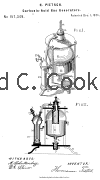
Click on images to see larger picture
Both of the machines shown above were small units, simple to operate
and relatively inexpensive; therefore, ideal for a grocer or
independent small scale bottler, who did not want to make a large
capital investment. Wheeler advertised his machine as being
suitable for “home use.” The cost necessary to establish a
small home based soda
pg. 6 |
|
pg. 7
water business was incredibly low. In 1891,
T.B. Ferguson purchased a soda machine, one lot of bottles,
including seltzer siphons and a wagon, horse and harness for only
720 dollars (see page 22).
Patented in 1891, J.F. Wittemann’s design, shown below, was
larger, complicated and more suitable for use by large scale
bottling plants. Due to its complexity, its method of
operation will not be discussed here.
It is interesting to note, that by the late 1880’s most of the new
carbonator patent designs employed the use of a cylinder of
compressed carbon dioxide gas. People were not submitting as
many designs for machines that made their own carbon dioxide gas
with sulfuric acid and other dangerous chemicals. Shown below
is a carbonator design patented by P.E. Malmstrom in 1892.
His device used a cylinder of compressed carbon dioxide gas to
produce soda water. This machine was relatively uncomplicated
and it produced a soda water solution by simply moving a handle back
and forth. In using this machine, the compressed carbon
dioxide cylinder valve (B) was opened, allowing the gas to flow to a
double valve (H/I). The double valve could be positioned so as
to allow the gas to enter vessel R or S, both of which contained
water. As the gas began to dissolve in the water, manipulation
of valve/s H/I made the solution flow back and forth from vessel to
vessel through tube T. The direction of the flow was
determined by the position of the valve/s. Malstrom
claimed that by “alternating the valves H, I a sufficient number of
times the water is thoroughly agitated and impregnated by the
carbonic acid".
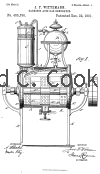
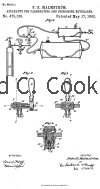
Click images to see larger picture
pg. 7 |
|
pg. 8
The wide variety of soda machine patents issued in the late
nineteenth century leaves us to wonder which designs were popular
with small town bottlers. Several factors contributed to their
choice. One is the availability and cost of compressed carbon
dioxide gas. In order for this gas to be efficiently
transported, it had to be compressed to such a degree that it became
a liquid. In this form it must be kept in a steel cylinder at
a pressure of several thousand pounds per square inch. The
machinery necessary to produce large quantities of gas and to
compress it to such a high pressure was found only in large
industrial cities, particularly those in the north. The cost
of the gas was high and the heavy cylinders were expensive to rent
and ship. These costs kept such modern technology out of the
hands of many small scale bottlers for years. Small soda-acid
machines were much more economical than machines that required
compressed gas. Another factor that favored the continued use
of soda-acid machines was their availability. When a bottler
changed his business interests, he would sell his equipment and/or
bottles to another individual at a bargain price (see pages
27 and
30).
PART TWO—BEER
For many centuries beer has been brewed using the same basic
ingredients and procedures. The equipment used in brewing is
similar, irregardless of whether the scale is large or small.
In this discussion of the brewing process, reference will be made to
the map of Brunswick Brewing & Ice Company shown on
page 56 and the
equipment that it contained as listed on
pages 58-61.
The key ingredient in the brewing process is barley grain which has
been “malted” by allowing it to soak briefly in water. During
this process the barley grains begin to sprout or “germinate”.
When the sprout reaches a certain length, the germinating process is
stopped by drying the grains in a heated chamber. Certain
enzymes formed during germination have the ability to convert
starches in the seed into sugars, such as maltose, that can be
fermented into alcohol. Being a somewhat small scale brewery,
Brunswick Brewing & Ice Company purchased “malt” as opposed to
un-malted grain (see advertisement on page 57). This allowed
them to simplify brewing by avoiding the malting process and its
associated equipment. Therefore, at this facility, the first
processing step was to grind the malted grain into smaller pieces,
called “grist,” and separate them from the seed husk. Malted
grain was delivered to the BREWERY (page 56 map reference) also
called the BREWING HOUSE (page 58 document reference) building via
the side track of the East Tennessee, Virginia and Georgia Railroad.
Two elevators and conveyors raised the malt to the fourth floor of
the BREWERY where it was stored (see Map on page 56 and line 31 on
page 58). The “mill” shown on the second floor of the BREWERY
(see pages 55 and line 3 on
page 59) was the machine used to grind
the malted grain. The resulting grist was then weighed,
probably with the “large scale,” referred to in line 31 on page 58,
and then transferred to a large copper vat called a “mash tun” where
it was mixed with warm water. In this case the “mash tun” was
on the third floor of the BREWERY (page 55). In the mash tun,
water heated to 120-160 degrees Fahrenheit caused the enzymes to
reactivate. During this process, called “mashing,” the
reactivated enzymes break down most of the seed’s starch into
fermentable sugars. Additional starchy grains, such as corn
grist, called “adjuncts” may have been added during mashing.
The use of adjuncts in brewing was an American
pg. 8 |
|
pg. 9
innovation that provided an economical way to
increase the percentage of fermentable sugars in the filtered
liquid. However, the use of adjuncts is still literally
“against the law” in Germany. Brunswick Brewing & Ice’s
advertisement of German style beers leaves us to wonder if they used
adjuncts in their brewing process. After the mashing process
was completed, the enzyme activity was halted by heating the mixture
to 175 degrees Fahrenheit. The sugary liquid was then strained
from the remaining solid mass in a process called “lautering".
The mash tun was equipped with some sort of “false bottom” that
contained perforations that acted like a strainer. The grain
husks formed a natural filter bed that assists in the straining
process and a clear liquid called “wort” (pronounced wurt) flowed
from the bottom of the vessel. The “low bottoms” referred to
in line ten on
page 60 were probably false bottoms. In a
process called “sparging,” hot water is sprinkled over the spent
solids in the mash tun. This process recovers the last traces
of sugary liquid from the wort. The copper sprinklers referred
to on line eleven of
page 60 were probably used for sparging.
After lautering, the wort was moved to another vessel called the”
brew kettle” where it was heated to boiling. At Brunswick
Brewing & Ice Company, this vessel was also located on the third
floor of the BREWERY. Carefully weighed hops were added during
the boiling process. The scales referred to in line three on
page 60 was likely used for weighing hops. The resins
extracted from the hops helped to preserve the finished beer and add
bitterness that off set the sweetness of any remaining unfermented
sugars. The brew kettle at this facility was probably heated
with steam produced by two 100 horsepower boilers positioned at the
north end of the ICE MACHINE & DYNAMO room (page 56). For
lager type fermentation, the hot wort must be cooled to a
temperature of about 45 degrees Fahrenheit. This was
accomplished at the local brewery with a large copper cooler
supplied with refrigerated water from the ice plant (page 56).
In the traditional process, the wort flows to a “pitch kettle” (page
56 building No. 4 and line thirty-two on
page 59) where it is
thoroughly aerated before yeast is “pitched” (added with stirring).
At this stage of fermentation the yeast requires oxygen for proper
growth. The “air pump” (line thirteen on
page 59) and
“pitching machine” (line thirty-two on
page 59) were used to aerate
and mix the wort with yeast. At Brunswick Brewing & Ice
Company, the pitch kettle was in a different building and it is
likely that the wort flowed by gravity, possibly through the 100
feet of large copper pipe referred to in line seven on
page 60.
Once yeast was added to the chilled wort, active fermentation began.
The beers produced at Brunswick Brewing & Ice Company were made with
a bottom fermenting yeast that produced lager style beer.
During the fermentation process, the main part of which requires two
or three weeks, the fermenting mixture must be kept in a cooled
vessel that excluded air. The introduction of oxygen from air
would cause spoilage of the finished beer. Fermentation
produced carbon dioxide gas which was recovered, stored and used
later to carbonate the beer. The fermentation at Brunswick
Brewing & Ice Company was carried out in one or more of the
1000-1200 barrel tubs mentioned in line twenty-six on
page 59.
The design of these tubs in not apparent, but they must have had
some sort of lid with piping to remove the carbon dioxide gas and
exclude air. After initial fermentation, the resulting “green
beer” is stored in a cold environment for a month or more until it
becomes adequately aged. Storage at the local brewery may have
been accomplished in the many various sized casks listed in line
twenty-six on
page 59. Either of the “Cold Storage” buildings
shown on
page 56 could have been used to house the casks of aging
beer. By the latter part of
pg. 9 |
|
pg. 10
the nineteenth century various filtering devices
were invented that “brightened” the finished beer by removing small
particles of sediment. One such device, invented by Otto
Zwietusch, was used at the Brunswick Brewing & Ice Company
facility (see illustration below and line seventeen on
page 59).
Although this device was patented in 1895, it is perfectly
conceivable that it was in use earlier. Even modern devices
are sometimes identified with “patent applied for”, a term that
indicates they were marketed before a patent was actually granted.
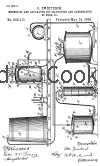
After “brightening,” the beer was sent to the
bottling house where it was pumped into wooden kegs or glass
bottles. The “100 brass spigots and 100 valves” mentioned in
line 21 of
page 59 probably accompanied the kegs to their retail
destination. Barreled and bottled beer was hauled by wagon to
the Brunswick Brewing & Ice Company’s distribution center at 202 Bay
Street (See map on page 41).
PART THREE—BOTTLES
This section presents a description of the types of soda and beer
bottles that were used in Brunswick in the nineteenth century.
In general, these represent the most common types of contemporary
soda and beer bottles in use in the southeastern United States.
Click image to see larger picture
Blob top soda bottles—Blob top soda
bottles were in use as early as the 1830’s in Charleston, South
Carolina. These bottles were designed to withstand the
physical rigors of being repeatedly filled, emptied and returned to
the bottler (see page 4). Consequently,
pg. 10 |
|
pg. 11
they were made with a thick glass body to which
an even thicker glass “blob” top was fitted in a molten state (such
tops are said to be “applied”). By the late 1880's
improvements in glass technology allowed the entire bottle to be
molded in one operation. However, the sturdy blob top shape
was retained. Soda bottles usually had a capacity of 8-10
fluid ounces. Because blob top soda bottles and their
associated technology were still being used in the first decade of
the twentieth century, those bottlers and their bottles are included
in a special early twentieth century section.
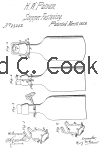
Click image for larger picture |
Type 1—Blob
top soda bottles with Putnam closures—The
first blob top bottles were closed with a cork stopper that was held
in place by a thin copper wire. The wire was necessary to
secure the cork against pressure generated by the carbonic gas
(carbon dioxide) dissolved in the soda water. However,
twisting the wire into place was a cumbersome and time consuming
task. In 1859 Henry Putnam of Cleveland, Ohio
invented an improved design that became the most popular closure for
the next 25 years. Henry’s description of the closure
verifies its convenience and ease of operation: “Whenever it
is desirable to uncork a bottle, the thumbs are placed upon the
sides AA and the fastener shoved from off the top of the cork, which
is instantly forced out of the bottle by the expanding gas.”
Although there are no known examples of this type of bottle embossed
with “Brunswick, Georgia", at least one Brunswick bottler purchased,
for his own use, retired blob top bottles with Putnam
closures from northern and Midwestern companies (see page 24).
Type 2—Blob
top round bottomed bottles—Sometimes
called “torpedo” or “ballast” bottles, these glass containers
differed from the traditional cylindrical shape by having thick
round bottoms. These bottles appear in the early 1860’s as
part of the cargo shipped from the British Isles to American ports.
British round bottomed bottles have an
pg. 11 |
|
pg. 12
interesting history. For stability, British
sailing ships, bound for American ports, required a considerable
amount of weight in their lower hull to stabilize their tall sails.
Ballast stones, which were discarded when the ships reached port,
provided most of the needed mass. However, a cargo of thick
glass round bottom bottles containing ginger ale also served very
well as ballast. The bottles were not only useful for adding
weight, but they contained a product that could be easily marketed
in American ports. In fact, so common are these bottles in
southern harbor towns that local bottle collectors usually refer to
them as “ballast bottles". During shipment round bottomed
bottles were stacked on their side in order to keep their corks
damp, swollen and well sealed. The corks were secured by the
same type of thin copper wire that was used prior to 1860 by
American soda bottlers. In the 1870's round bottomed bottles
became so popular that they were manufactured in this country for
American bottlers. Several types of round bottomed bottles
bear the name of the Savannah bottler, John Ryan.
At least one Brunswick bottler, Taylor Ferguson,
acquired foreign made round bottomed bottles that came into the
Brunswick port. He refitted them with Putnam closures and
filled them with his own products (see pages
28-29).
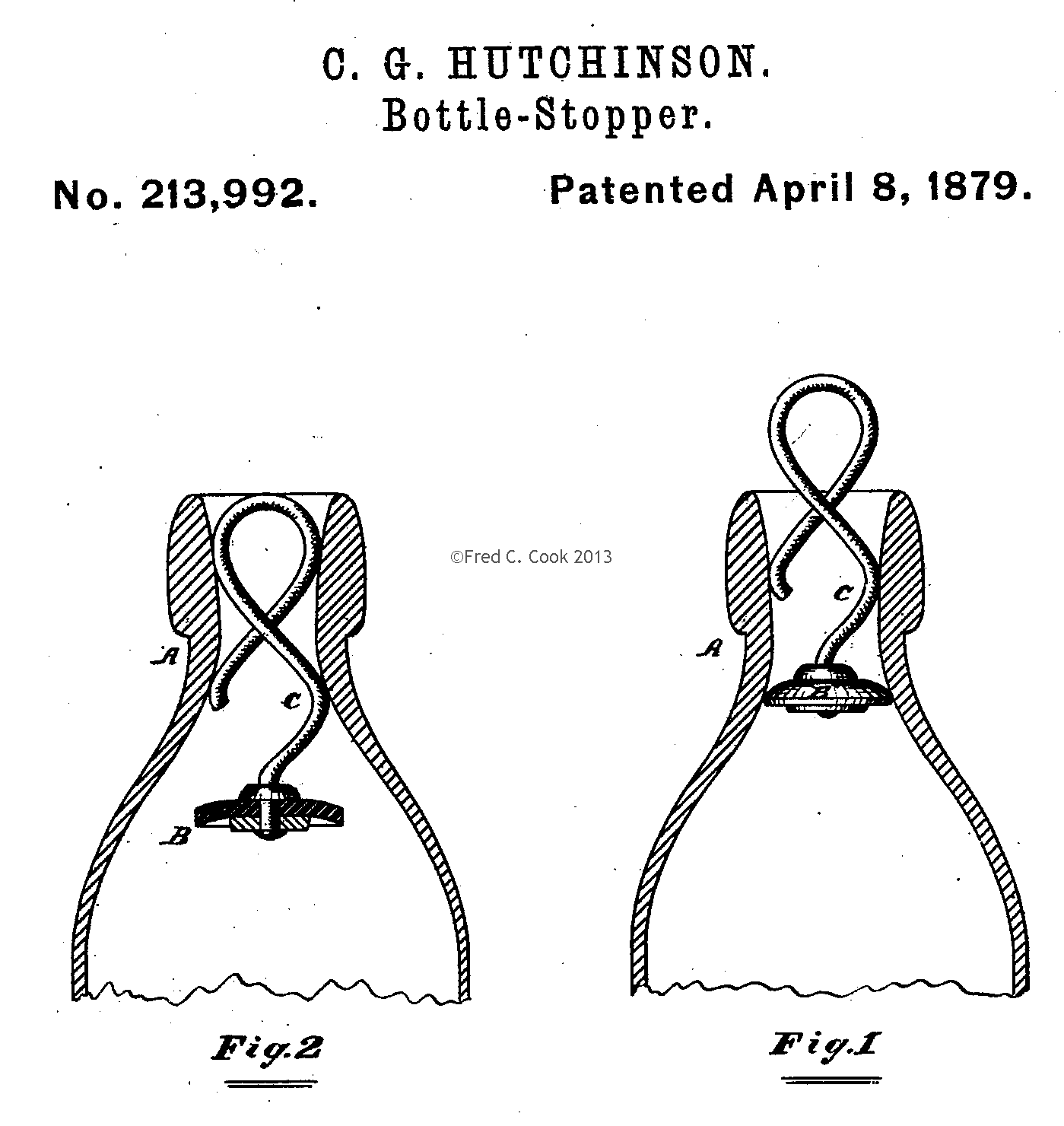 Type
3—Blob
top soda bottles with Hutchinson closures—Henry
Hutchinson of Chicago attempted to make the traditional cork
soda bottle closure obsolete with the introduction of his new
design, which was patented in 1879. Henry’s stopper
design used gas pressure from the soda water in the bottle to seal
it by applying a force against a flexible rubber gasket positioned
in the bottle’s neck. The container was opened by pushing a
stiff wire attached to the stopper downward. The bottle could
be easily resealed by pulling the wire upward. Although easy
to operate this design was inherently unsanitary. Dust, dirt
and germs could easily collect in the neck of the bottle and become
mixed with the contents when the bottle was opened. In spite
of this design defect, the Hutchinson closure had almost
completely replaced the Putnam closure by the late 1880's,
when soda water was first bottled in Brunswick. This was not
the case in nearby Savannah, where the cork/Putnam closed
blob top bottle had reigned for almost half a century. In
spite of its size and demand for soda products, Savannah soda
businesses acquired and used very few Hutchinson bottles
during the 1890's. It appears that technological change came
slow to this large city. The principal reasoning is that by
the late 1880's the Savannah bottlers had a huge investment in cork/Putnam
closed blob top bottles and the machinery that filled them. It
was much easier for new bottlers, such as Type
3—Blob
top soda bottles with Hutchinson closures—Henry
Hutchinson of Chicago attempted to make the traditional cork
soda bottle closure obsolete with the introduction of his new
design, which was patented in 1879. Henry’s stopper
design used gas pressure from the soda water in the bottle to seal
it by applying a force against a flexible rubber gasket positioned
in the bottle’s neck. The container was opened by pushing a
stiff wire attached to the stopper downward. The bottle could
be easily resealed by pulling the wire upward. Although easy
to operate this design was inherently unsanitary. Dust, dirt
and germs could easily collect in the neck of the bottle and become
mixed with the contents when the bottle was opened. In spite
of this design defect, the Hutchinson closure had almost
completely replaced the Putnam closure by the late 1880's,
when soda water was first bottled in Brunswick. This was not
the case in nearby Savannah, where the cork/Putnam closed
blob top bottle had reigned for almost half a century. In
spite of its size and demand for soda products, Savannah soda
businesses acquired and used very few Hutchinson bottles
during the 1890's. It appears that technological change came
slow to this large city. The principal reasoning is that by
the late 1880's the Savannah bottlers had a huge investment in cork/Putnam
closed blob top bottles and the machinery that filled them. It
was much easier for new bottlers, such as
pg. 12 |
|
pg. 13
those in Brunswick, to invest in Hutchinson
bottle technology than it was for an older established bottler to
replace his entire inventory of bottles and filling equipment.
The concept of technological upgrade may explain how Brunswick
bottler, Taylor Ferguson, happened to acquire cork/Putnam
closed blob top bottles from northern bottling companies at cut rate
prices (see page 24).
As mentioned above, the change in technology from cork/Putnam
closures to Hutchinson closures in the late 1880's is
reflected by the fact that all blob top soda bottles embossed with
the name of a Brunswick bottler are of the Hutchinson type.
Type 4—Seltzer
or siphon type bottles—At
least four Brunswick bottlers filled and distributed high pressure
soda water in these thick glass containers. All of the examples of
Brunswick siphon bottles found thus far were broken. None of these
were embossed or etched with a local bottler’s name. A somewhat
contemporary siphon bottle closure and its associated tool, patented
by John Brown of Medford, Massachusetts, are shown below. Because of
the high pressure of the carbonated water, these bottles seemed to
have required a complicated and expensive filling device, such as
the one invented by John Matthews. The siphon bottle shown below in
John Matthew’s filling machine is the same type of bottle that was
used by Taylor Ferguson of Brunswick.
|
 |
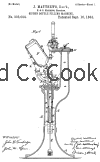 |
|
Click images for larger
picture |
Beer bottles—The walls of these bottles
were generally thinner than soda bottles, probably because the beer
was not as highly carbonated as soda water and pressures within the
bottles was less. In general, beer bottles have a more
elongated cylindrical shape than soda bottles. Almost all of
the Brunswick beers have a capacity of 12-14 fluid ounces, but at
least one small bottle is known that has a capacity of only 7
½ ounces. The
pg. 13 |
|
pg. 14
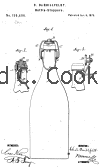 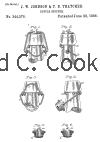 no-return
beer bottles have a double collared top or blob top that was sealed
with a straight cork held in place by a simple twisted copper wire.
None of these bottles are embossed with a Brunswick bottler’s name.
All of the beer bottles, embossed “Brunswick”, have blob tops and
these were sealed with two different types of closures. no-return
beer bottles have a double collared top or blob top that was sealed
with a straight cork held in place by a simple twisted copper wire.
None of these bottles are embossed with a Brunswick bottler’s name.
All of the beer bottles, embossed “Brunswick”, have blob tops and
these were sealed with two different types of closures.
Type 1—Blob top beer bottles
with lightning closures—In 1876 Charles DeQuillfeldt
of New York City patented a new device that sealed a bottle by
forcing a rubber lined cap against the interior and exterior
surfaces of its lip by means of a lever like iron wire yoke.
Karl Hutter immediately purchased the rights for this
patent and began manufacturing the closure. Later, it became
known as the “lightning stopper". One Brunswick beer bottle, “Robert
Grier”, has “K. Hutter New York” embossed on its base.
The few bottles that have been found with the remains of their
closures indicate that the design present was more like that
patented by Johnson and Thatcher in 1886.
[Click images to see larger picture.]
Type 2—Blob top beer bottles
with William Painter type closures—Beer bottles embossed with
“Brunswick Brewing & Ice Company” and P.H. Wolter
Philadelphia have closures that are of the type invented by
William Painter of Baltimore, Maryland in 1885.
This type is also referred to as the “Baltimore loop”. These
bottles had a groove in the interior of the applied blob top.
In filling with a carbonated beverage, such as beer, the bottle was
sealed by an inverted disk of flexible material, fixed into the
groove. The disc was smaller than the groove so it had an
internal bend that sealed the pressurized contents.
Frequently, it had a wire with a loop attached to its center.
To open the bottle a finger was inserted into the loop and adequate
pressure was applied to remove the disk.
pg. 14 |
|
pg. 15

William Painter’s Patent for the “Baltimore Loop.”
pg. 15 |
|
pg. 16
CHAPTER THREE—BRUNSWICK’S
NINETEENTH CENTURY SODA BOTTLERS
Brunswick Bottling Works—Little is known
of Brunswick Bottling Works. However, it was probably the
first company in Brunswick to bottle soda water. The company
was apparently out of business in 1890, when the first city
directory was published. The bottles owned by the proprietors
of Brunswick Bottling Works were sold to Brunswick Brewing & Ice
Company sometime after its establishment in 1889. Brunswick
Bottling Works was one of the two companies in Brunswick that used
bottles with applied tops. Most American glass works phased
this technology out in the late 1880’s; therefore, the pre-1890 date
assigned to this business is supported by the method by which these
bottles were produced and the company’s absence in the first city
directory. The only two types of Brunswick Bottling Works
bottles are shown below,
|
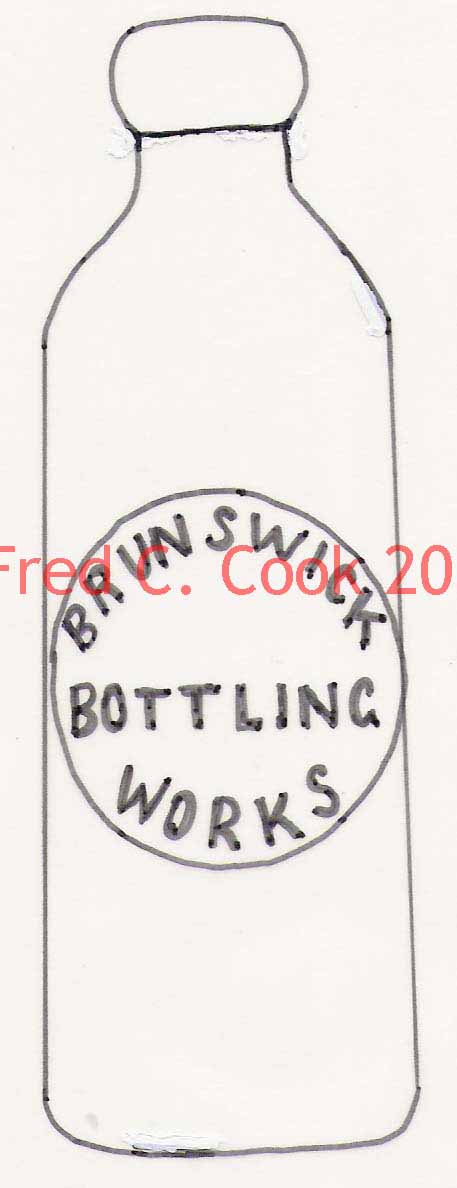
S101.1 -- Tall/aqua/applied top/soda/
Hutchinson stopper
Height -- 6 23/32”
Diameter -- 2 11/32” |
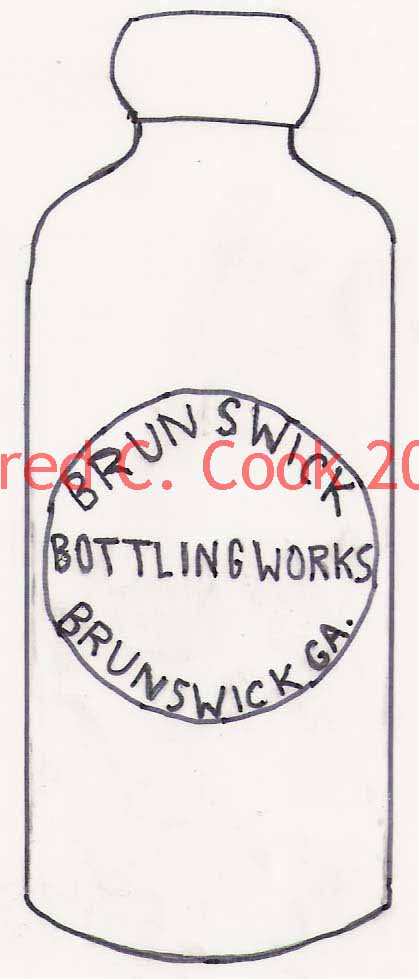
S101.2 -- Squat/aqua/applied top/ soda/
Hutchinson stopper
Height -- 6.0”
Diameter -- 2 7/16” |
Oglethorpe Bottling Works—was owned and
operated briefly from 1887 to 1889 by George D. Hodges and
other investors. George Hodges was from Quitman,
Georgia, but it is not know when he moved to Brunswick.
However, George’s name appears in the registered voter lists
published in the Brunswick Daily Advertiser-Appeal at least as early
as December 5, 1885. As shown in the newspaper
advertisements on pages
19-20, Oglethorpe Bottling works probably
operated under the general proprietorship of George Hodges’
Drug Store. Several documents in the Glynn County Property
Records verify that George Hodges and George
McCauley were in business together as early as September 26,
1886 when they bought a safe for their business. On January
20, 1887 they bought a Fancy Siberian Arctic Dominion #1196 soda
fountain and two 14 gallon copper founts from James W.
Tufts in Boston, Massachusetts. The next year they made
two
pg. 16 |
|
pg. 17
related purchases. The first, purchased on
April 5, was equipment and siphon bottles, also from James
Tufts. The equipment included a Black & Fancy Siberian
Atlantic Constitution #772. The second, on November 18th
was a SGC(?) bottling table with a Number 2 solid plunge sink gauge
and Hutchinson attachment. The 1890 Brunswick City
Directory lists George Hodges as a druggist, but makes
no mention of Oglethorpe Bottling Works. As seen in the
newspaper advertisements below, Oglethorpe Bottling Works
manufactured a complete line of soda water, which included lemon,
ginger ale, sarsaparilla and strawberry flavors. The soda
bottles used by this firm all had applied tops, which, as mentioned
above, indicate that the business did not function after about 1890.
George Hodges’ name reappears in the 1892 city
directory as a mineral water bottler associated with C.O. Marlin
& Company located at 416 Bay Street. No bottles embossed with
C.O. Marlin are known to exist. George is not
advertised as a druggist in 1892 and it is not know if he was ever
legally qualified to practice pharmacy [According to Physician &
Druggist licenses in the Glynn County Probate Court, yes, George
was licensed,
click here--ALH] . His residence was a one story wood
frame house at 1003 Davis Street
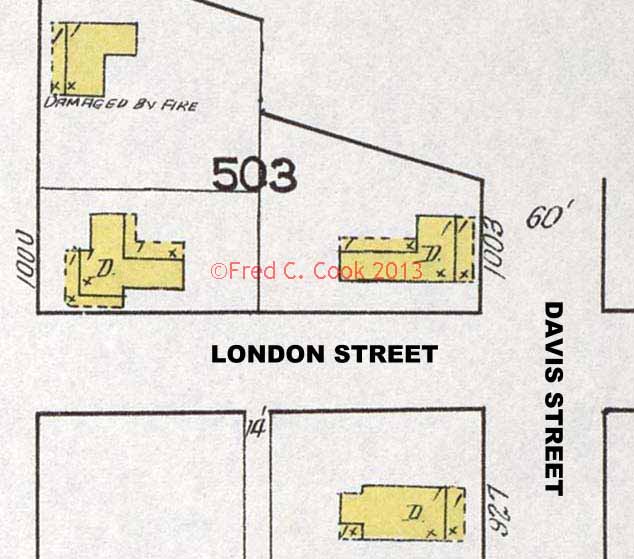
George Hodges house on the NW
corner of London & Davis Streets.
To the Right: “Geo.
D. Hodges Druggist Brunswick, GA.” pharmacy bottle. |
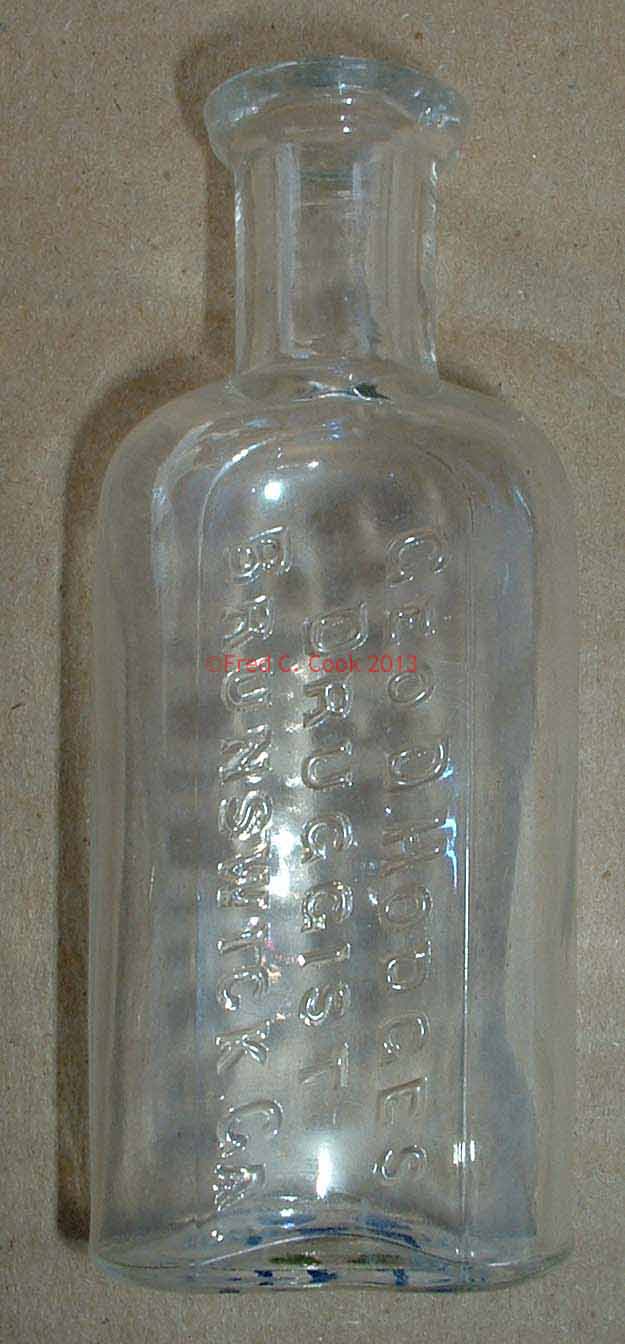 |
The following newspaper item shows that George
had a good sense of humor. This amusing story was told
directly to T.G. Stacey, editor of the Brunswick
Daily Advertiser-Appeal who published it on
Tuesday March 13, 1888:
A Big Man
Mr. George Hodges met us this morning and
told us that we might make the following announcement.
Said He: “I have
got the finest horse, the finest cow, the finest dog, the
finest boy and the prettiest wife in town, and to cap it all,
I am the ugliest man in town.”
pg. 17 |
|
pg. 18
Another personal mention in the same newspaper, published on the
previous Friday, follows:
Mr. George Hodges, is back from a trip to his old
home, Quitman. He reports everybody in that section
enthusiastic over the water-melon prospects. Every farmer in
reach of the railroad is putting in from 10 to 35 acres in melons.
The Southwest Ga. melon has gained a big reputation in the North and
Northwest, and always commands fair prices.
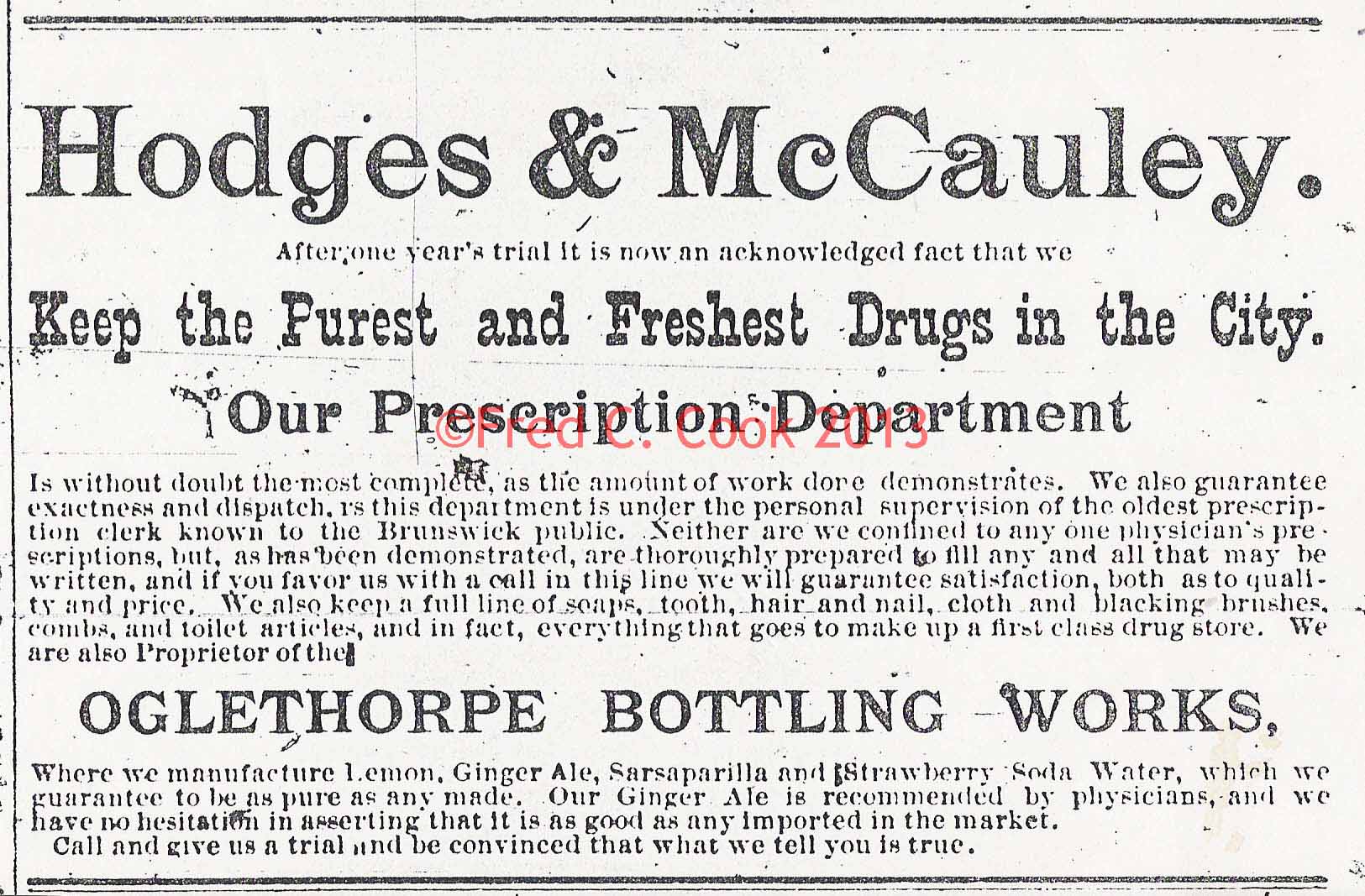
Brunswick Daily Advertiser-Appeal Wednesday January 18, 1888.
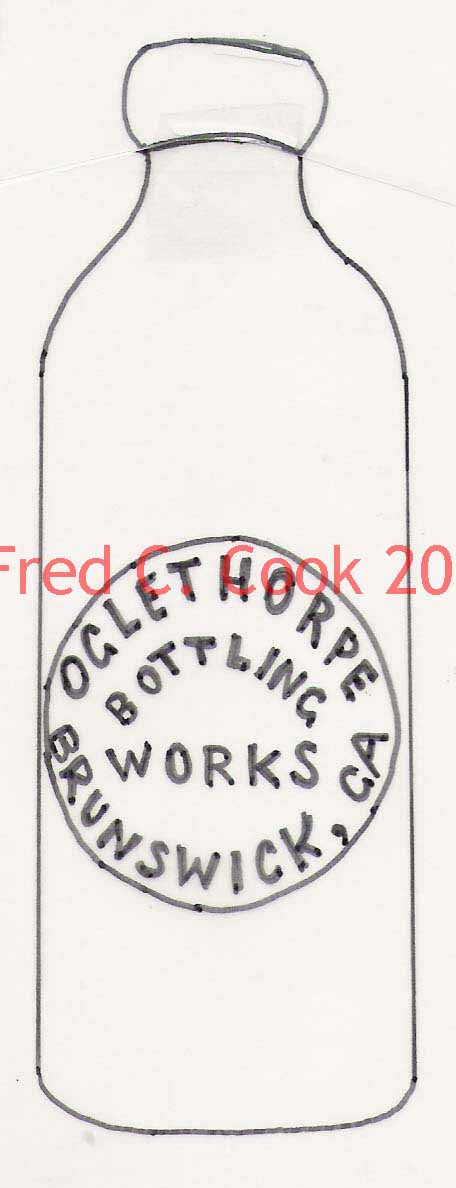
S102.1 Teal aqua/applied flat rim top/soda/Hutchinson stopper
Height- 6 13/16”
Diameter- 2 7/16”
|
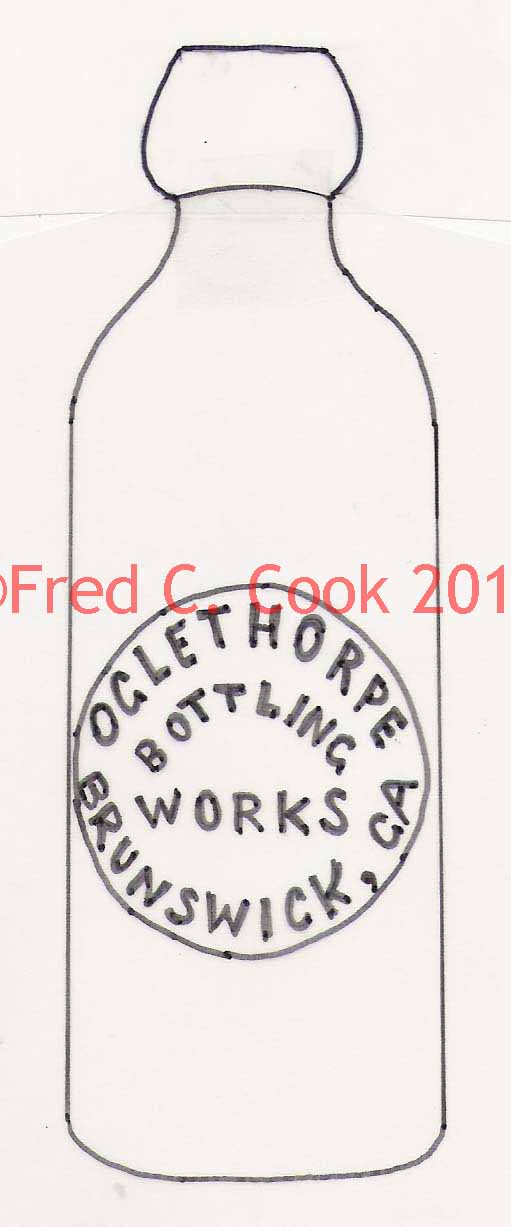
S102.2 Teal aqua/ applied tapered rim top/soda/ Hutchinson
stopper.
Height- 7 .0”
Diameter- 2 7/16”
|
pg. 18 |
|
pg. 19
Brunswick Daily Advertiser-Appeal Monday
February 6, 1888.

Brunswick Daily Advertiser-Appeal Saturday
September 21, 1889.
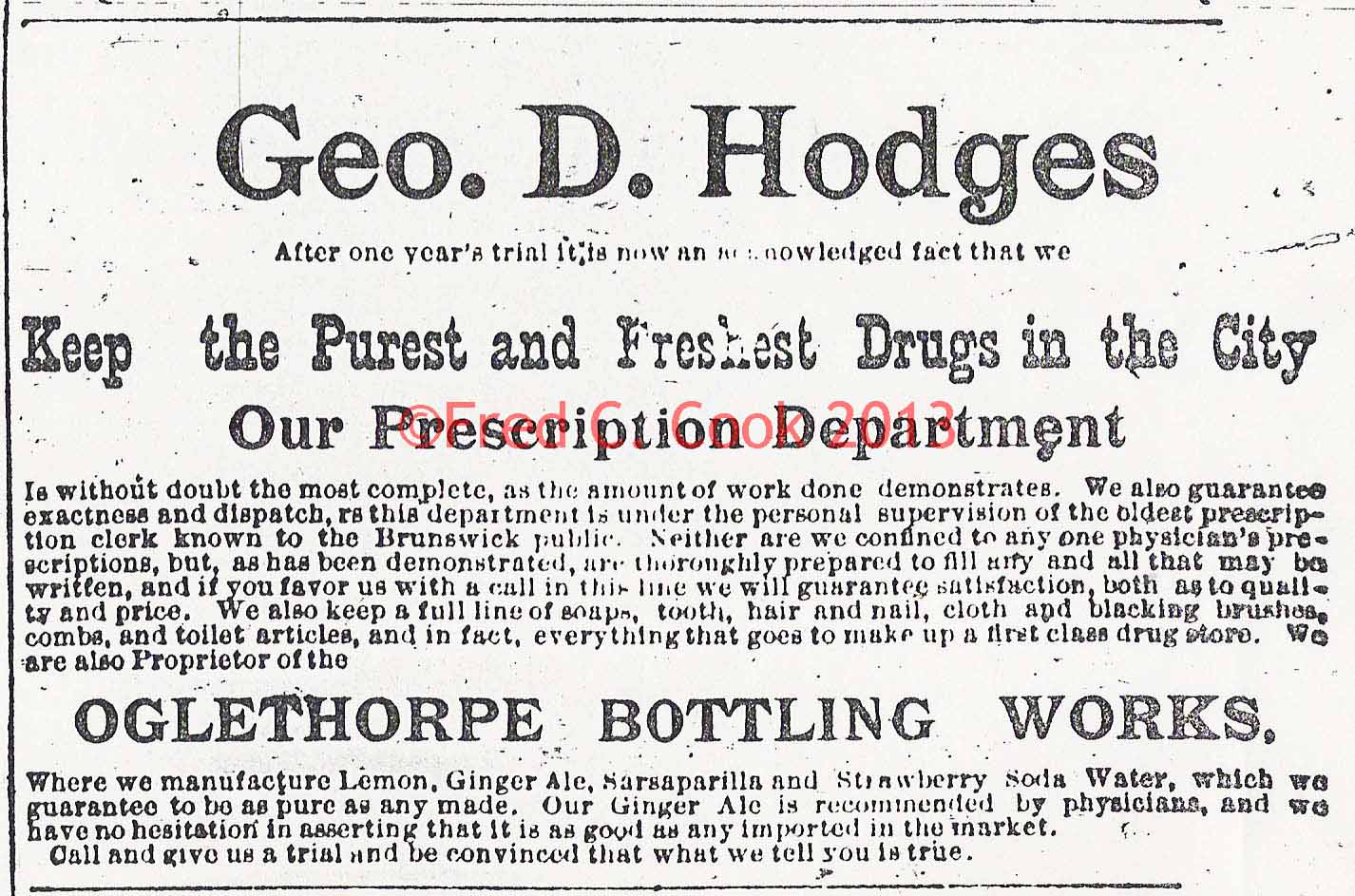
pg. 19 |
|
pg. 20
Brunswick Brewing & Ice Company—manufactured
beer, ice and soda water. The following advertisement appeared
in the 1892 city directory:
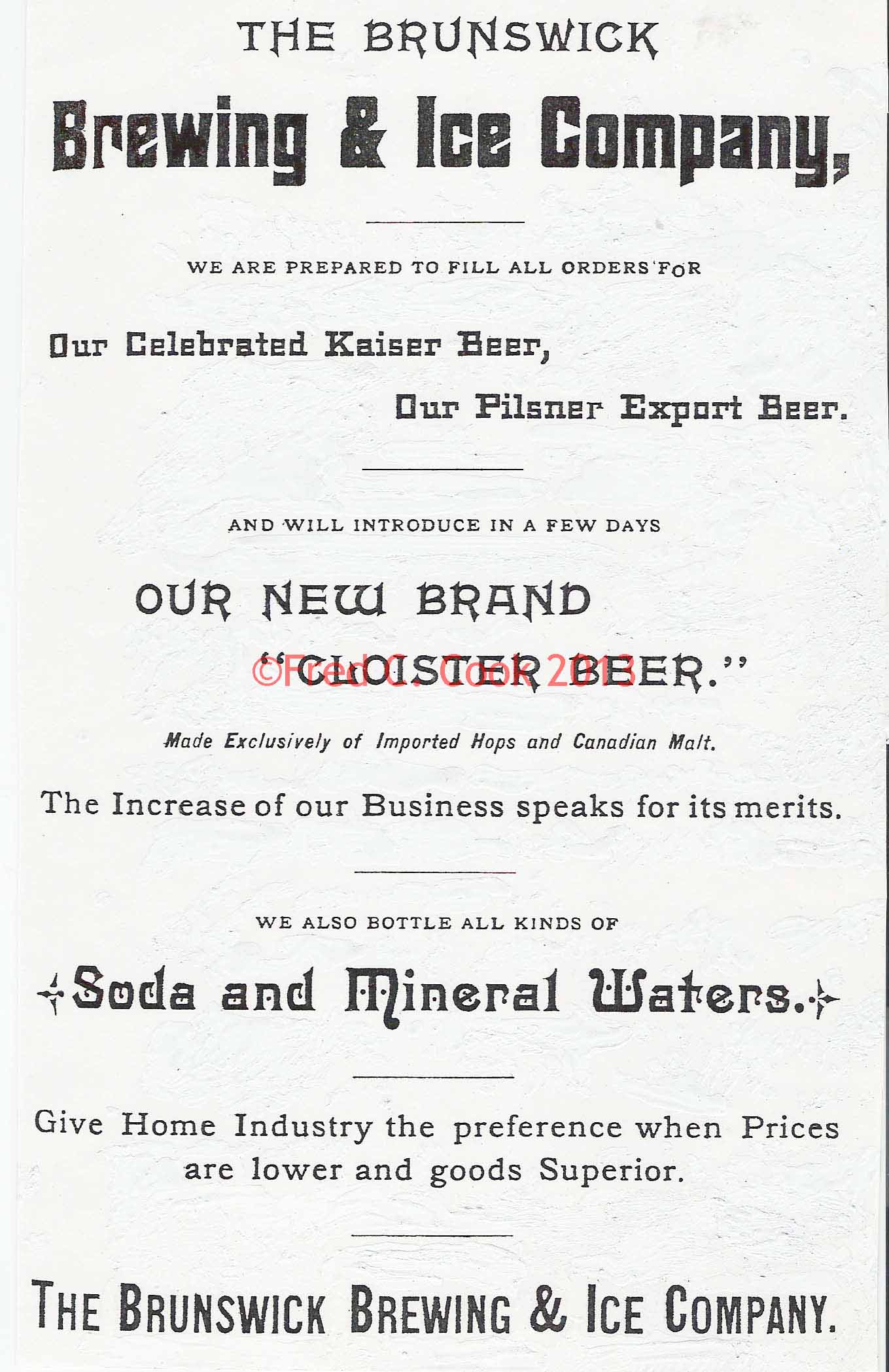
The same directory identifies the “beer and mineral water
department” at 202 Bay Street (see map on page 41). This
location was the company’s distribution office. Since this
firm’s main business was brewing, it will be discussed in detail in
Chapter Five with reference to their extensive works on Albany
Street. Shown below is the only type of soda bottle embossed
with the company’s name:
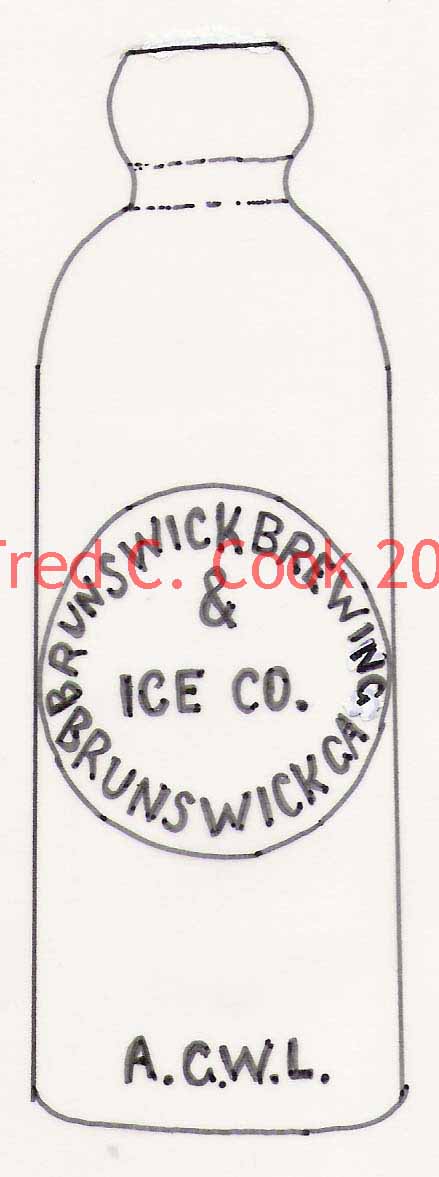
S103.1
Aqua/ tooled top/soda/ Hutchinson Stopper
Height- 6 ¾”
Diameter- 2 11/32”
pg. 20 |
|
pg. 21
T.B. Ferguson (Taylor Butler Ferguson)
was a Civil War veteran who served in Company C of the 5th
Georgia Infantry. His unit was formed in Richmond County,
Georgia. Since the US Census reports his place of birth as
South Carolina, it is likely that he was from the western region of
the state near Augusta.
After the war, Taylor moved to Brunswick and worked as a
plastering contractor. The following note was published in the
personal mention section of The Brunswick Daily Advertiser-Appeal
on August 2, 1876:
“Mr. T.B. Ferguson is putting on the finishing touches to
the Moore & McCray store. It is an imitation of granite, and
is certainly very neat.”
In 1880 Taylor married “Mattie” (Martha
Lambright). The Ferguson couple became the parents
of five girls and one boy.
By 1890 the Fergusons had built a comfortable home at 618
Cochran Avenue in the Brunswick suburb called “Dixville.” The
Ferguson home was a high gabled wood framed structure with
wide front and back porches.
The historic property map of the house shown on
page 22 suggests that the
original back porch had been enclosed and a rectangular extension
added sometime before 1910. These modifications were probably
made as the Ferguson family grew. Twin chimneys served
four fireplaces, one located in each of the house’s big rooms.
In spite of its solid construction, local authorities condemned the
Ferguson home and ordered it to be demolished in September,
2001.
The Brunswick Advertiser-Appeal December
13, 1876

The Brunswick Advertiser-Appeal April 10,
1880
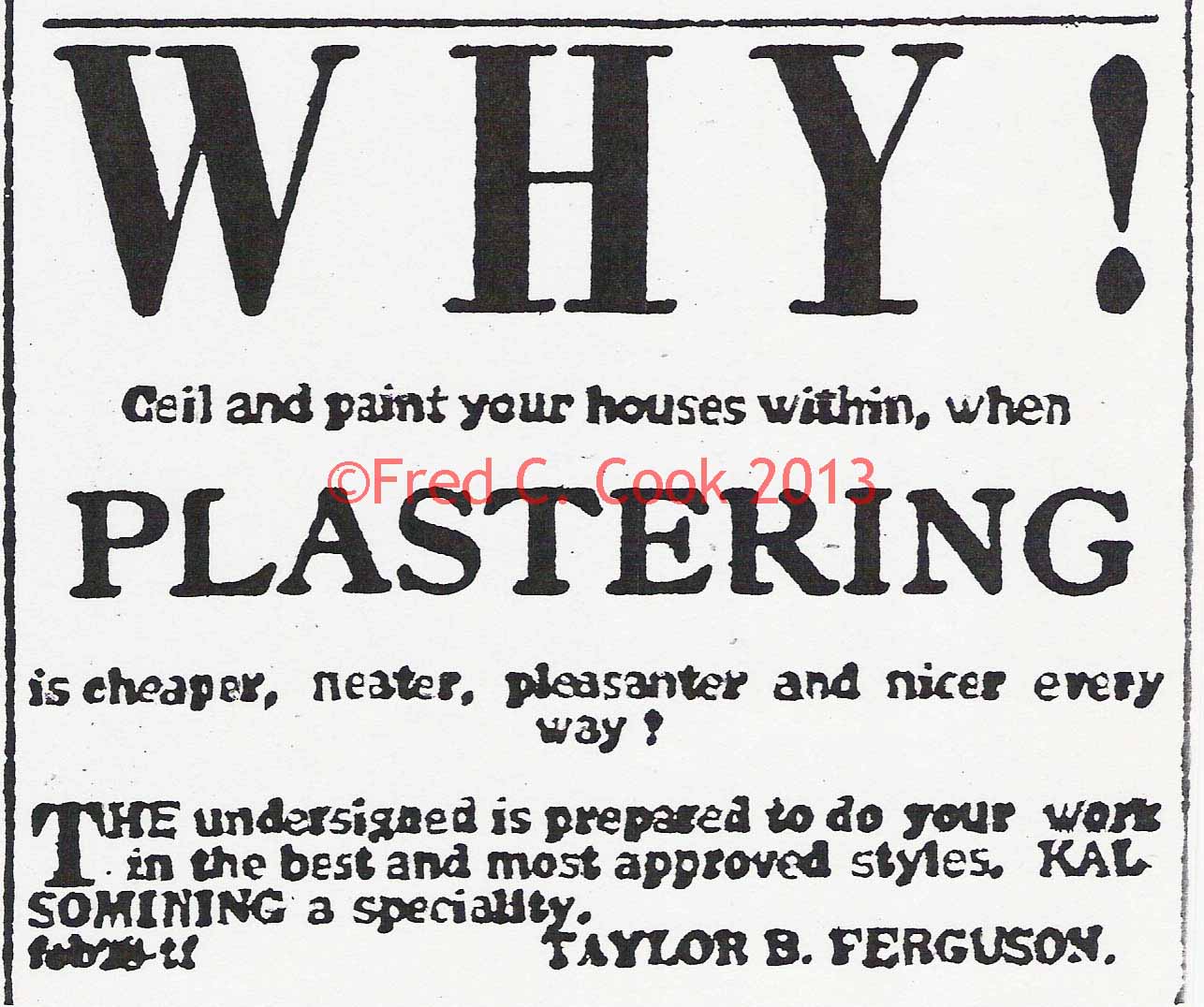
pg. 21 |
|
pg. 22
It is indeed fortunate that photographs of the house were made
before its destruction. The study of the Ferguson
family history was supplemented by excavations in the back lots of
616 and 618 Cochran Avenue.

Rear view of the Ferguson home and bottling
plant. Photo taken in 2001.
Note back porch, “bottling room” and rectangular extension have been
removed.
Recorded Jan 5th
1892
Edwin Brobston
Deputy Clerk
State
of Georgia
County of Glynn
$72000 Brunswick January 6th 1892
For value received to wit. One soda
water fixture for the manufacture and bottling of soda water
one lot of bottles one lot of siphons and one horse and wagon
and one harness. I promise to pay to the order of James
E. Lambright Seven Hundred and twenty ( 72000
) Dollars, The said amount to be paid in forty eight monthly
payments of fifteen dollars per month until the full amount is
paid
pg. 22 |
|
pg. 23
Commencing on the
first day of March 1892 and do hereby create a lien on the
above described property in favor of the said James E.
Lambright until this note is paid in full.
witness
J Michelson
Taylor B. Ferguson
L J Leavy Notary Public Glynn Co Ga
Taylor borrowed the 720 dollars necessary to begin his soda
water business, free of interest, from his father-in-law James
Edwin Lambright, who served as local justice of the
peace, with office at 508 Monk Street.
A small scale soda business seems to have been a risky venture
considering the overwhelming competition of Brunswick Brewing & Ice
Company, which was only 7 blocks south of Taylor’s business.
Manufacturing soda water may have been a part time endeavor for him,
but the local directories from 1892 through 1901-02, list Taylor
only under the description of “soda water manufacturer”. He
probably operated his business from the small room he created by
enclosing a portion of the old back porch at 618 Cochran Avenue.
However, the 1898 city directory indicates that for some time he
used the small wood framed house next door at 816 Cochran Avenue as
a business location. Excavations in the back yard of the lot
at 816 produced 10 refuse pits. Taylor had disposed of
several thousand bottles in these pits, most of which were broken
(see the Ferguson property map on page 26).

Cross section of the northern most of Taylor
Ferguson’s
bottle refuse pits behind 816 Cochran Avenue.
A four foot by four foot wood lined pit privy into which Taylor
had routed a sink drain line and a barrel privy were also found
there. The square privy contained several
pg. 23 |
|
pg. 24
bottles and a large mass of oyster shells, while
only a monkey wrench was found in the barrel privy. Three
privy pits were found behind the Ferguson home, but none of
these contained any bottles. A wood burning stove was found in
one of the privy pits. In contrast to the privies another nine
refuse pits were found in vacant lots to the south of the
Ferguson home and these also contained hundreds of bottles.
All of the refuse pits south of the Ferguson’s house were in
two lots that were not owned by the Fergusons.
Taylor dug these pits close to property lines. Their
placement suggests that he did not want them to be discovered in the
event that anyone should disturb the ground during new house
construction. Most of the bottles from the nineteen refuse
pits found on the three lots were blob top soda water containers.
A small minority of the bottles were seltzer siphons, imported round
bottom ginger ale, Woolf’s disinfectant (chlorine bleach), and plain
un-embossed quart sized syrup or sulfuric acid (see Chapter One)
bottles. One bottle contained solid lime, a chemical often
used to sweeten or purify water. A broken olive green wine
bottle with a partially preserved paper label was found in one of
the refuse pits (see photos on page 25). The paper label
depicts a young girl with an apron full of apples standing in front
of an apple tree. At the bottom of the label is a wooden sign
that has T.B. Ferguson, Brunswick Georgia written on it.
The depiction of the product’s name is partly missing, but it may
translate to “Old Apple Cider.” The soda bottles found in the
refuse pits included types representing over fifty different
businesses located in a number of northern and Midwestern states, as
well as a large number of Brunswick Brewing and Ice, Oglethorpe
Bottling Works, Brunswick Bottling Works, Crosby & Smith
and local competitor Lena Markowitz bottles.

Chicago, New York, Philadelphia and other applied
blob soda bottles with Putnam wire closures
found in T.B. Ferguson’s refuse pits.
pg. 24 |
|
pg. 25

Right side view showing girl with apple tree in the
background. Letters “ER” in a red banner at the top.
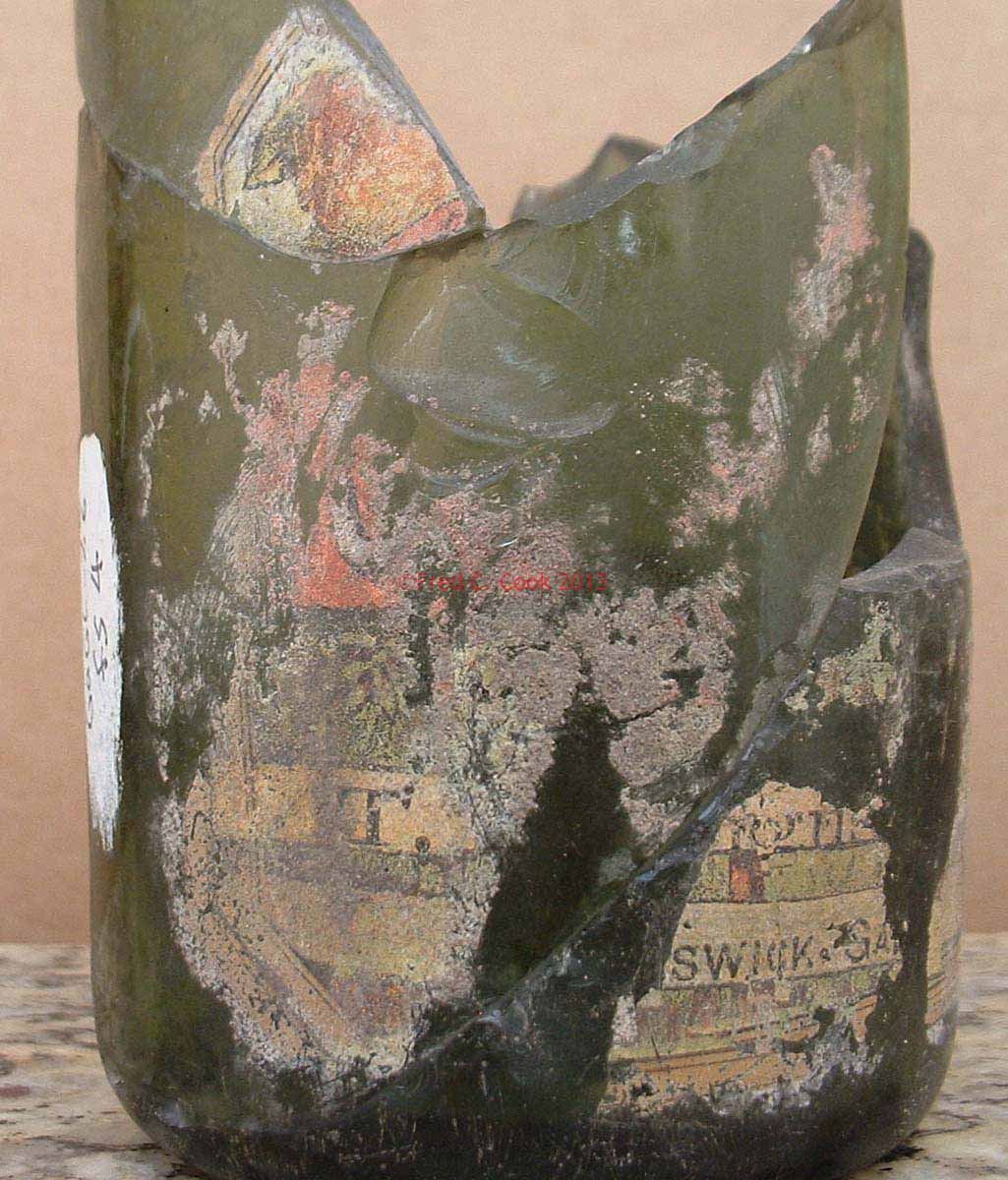
View 2 showing “ T….rgus” and “swick, Ga” on a board
sign, a picture of an apple and an “O?”in a red banner.
This interprets as T.B. Ferguson
Brunswick, GA.
pg. 25 |
|
pg. 26

Map of Taylor Ferguson’s structures on
Cochran Avenue. Red figures are privies.
Blue figures are bottle refuse pits. Long straight lines are
property lines or fences.
pg. 26 |
|
pg. 27

Some of the complete or nearly complete bottles
found in T.B. Ferguson’s refuse pits.
The presence of so many local bottles in the refuse pits seemed
unusual until the following document was found in the Glynn County
Records:
Book P. P. page 690
State of Georgia
County of Glynn,
Know all men by these
presents, that we, The Artesian Ice and Manufacturing Company, a
corporation under the laws of the State of Georgia, with our chief
office at Brunswick, in said State and county, do hereby for and in
Consideration of the sum of Twenty-five Dollars, ($ 2500
) Cash to us in hand paid, at and before the sealing and delivery of
these presents, the receipt whereof is hereby acknowledged, sell and
convey unto Taylor B. Ferguson,
pg. 27 |
|
pg. 28
of Glynn County, Georgia all
our right, title, interest, claim and demand of every character,
both in law and equity, of, in and to all of
those glass bottles of various sizes and dimensions with the cases
made for holding same, all of which formerly belonged to the
Brunswick Brewing & Ice company, a corporation under the laws
of the State of Georgia, and which were by the Receiver thereof, J.L.
Beach under the order and decree of Glynn Superior Court, sold, with
other property unto W.E. Cay, Trustee, for certain persons, and
afterwards by said bidders their said bid and interest was
transformed for value unto The Artesian Ice & Manufacturing Company,
and said Receiver directed to execute title to said corporation
aforesaid, which deed said Receiver duly executed and delivered on
December 1st 1895, and the said bottles being identified
by the stamps “The Brunswick Bottling Works”
blown on bottles, likewise all of those bottles with the words
“Oglethorpe Bottling Works,” blown thereon, and as well all those
other bottles with the words, “The Brunswick Brewing & Ice Company”
blown thereon, the quantity of said bottles not being capable of
specific enumeration but containing fifty gross, more or less…..
So in 1897 Taylor purchased the 7,200 (fifty gross-
see page
60) soda bottles formerly owned by Brunswick Brewing & Ice Company
for the grand total of $25.00 or about 1/3 of a cent per bottle.
Although they are not mentioned here, it is quite likely that this
lot of bottles also included those embossed “Crosby &
Smith”. With such a small investment Taylor could
afford to be careless with them. Bottles that had minor damage
or a defective rubber seal were expendable. It also seems
likely that local competitor Lena Markowitz’s bottles,
put accidentally put into Taylor’s wooden crates at the local
stores, were also expediently discarded. In addition to the
aforementioned bottles, Taylor acquired, perhaps from local
grocers and/or the consumers themselves, a large number of round
bottom “torpedo” bottles. As mentioned above, he refitted
these bottles with the more effective American made Putnam
iron wire bails, which were in common use on soda bottles after
1859. Taylor probably used these bottles for his ginger
ale and/or birch beer. The photo below shows the items found
in a privy across the railroad tracks from Taylor Ferguson’s
house. Note Taylor’s refitted “ballast bottles” with
the rusted remains of Putnam wire bails attached to their
necks.
pg. 28 |
|
pg. 29
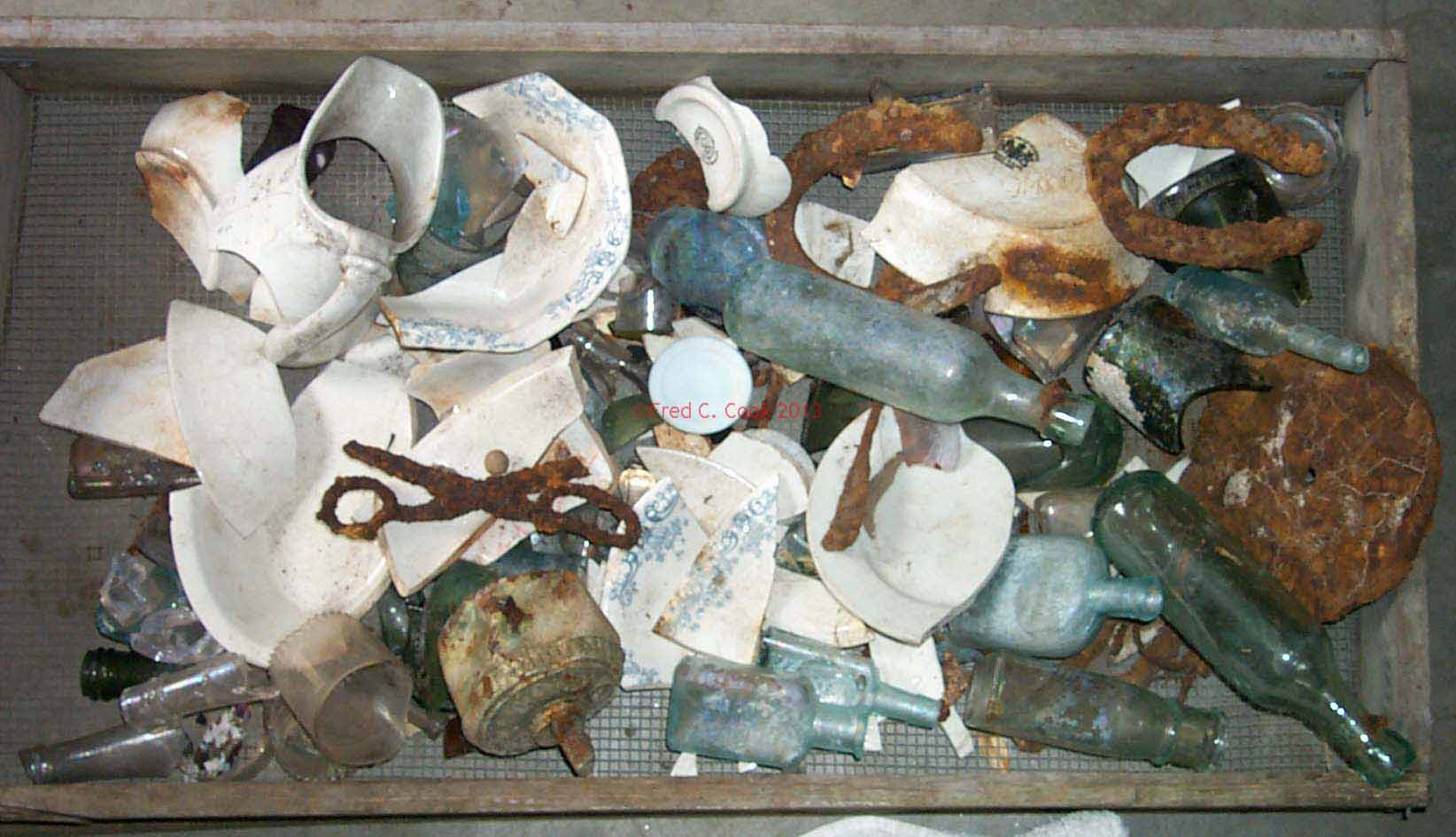
Brunswick Call June 6, 1899
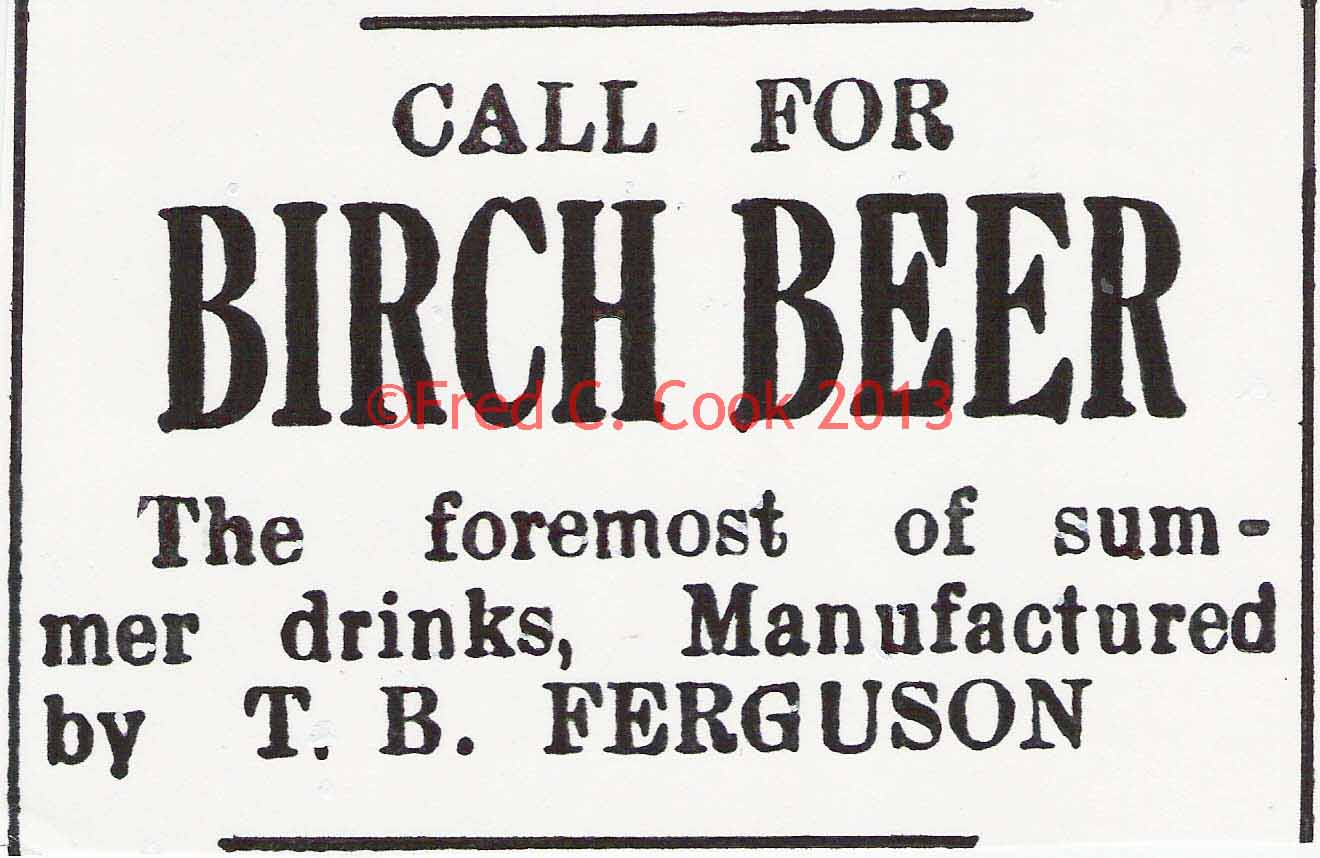
The two styles of soda bottles that bear Taylor Ferguson’s
name are shown on the following page. The taller version with
a “mug base” may have been used exclusively for birch or root beer.
pg. 29 |
|
pg. 30
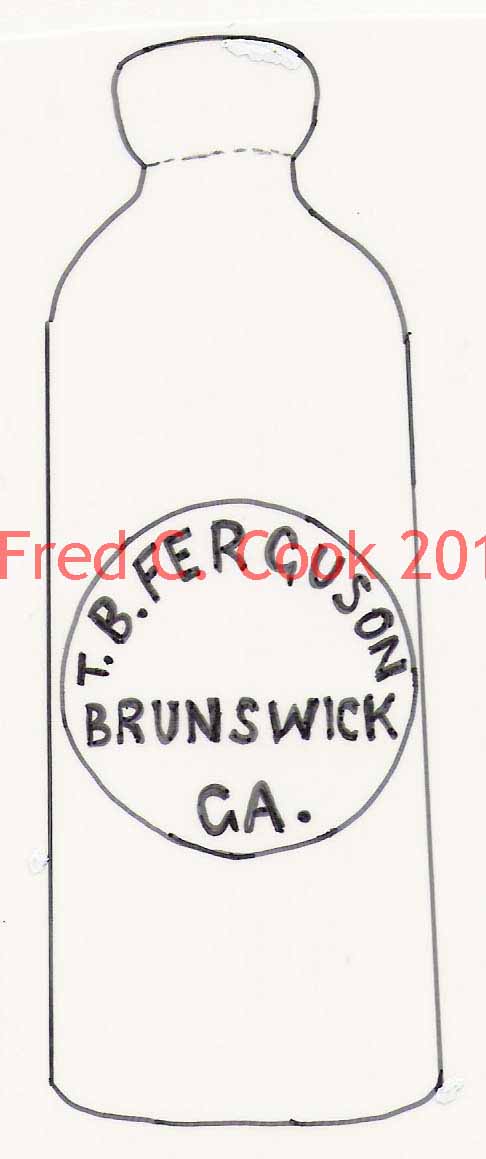
S105.1 Aqua/ short/ tooled top/ soda/ Hutchinson stopper
Height- 6 5/8”
Diameter- 2 ½” |

S105.2 Aqua/ tall/ mug base/ root beer/ Hutchinson stopper
Height- 7 9/32”
Diameter- 2 3/8” |
The following advertisement, published in the Brunswick
Times Call on March 5, 1901 verifies the end of T.B.
Ferguson’s bottling business and the beginning of Louis
Ludwig’s. From 1898 until at least 1902 Louis
Ludwig owned and operated a grocery business two blocks east of
the Ferguson home.
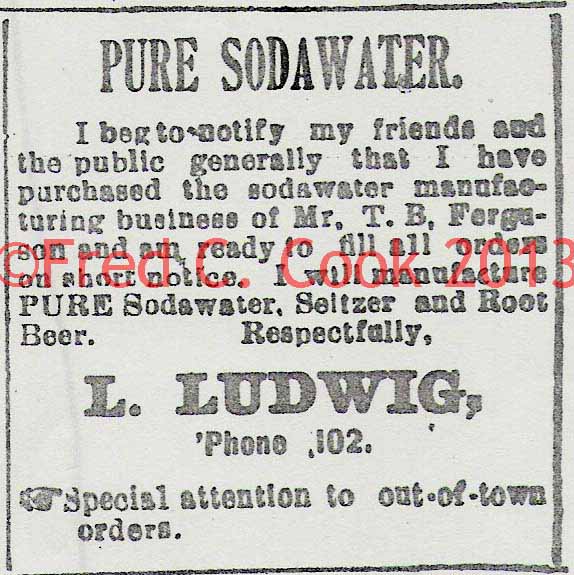
The Ferguson family continued to live at
618 Cochran Avenue, but Taylor went back into the
construction business as a “plastering”contractor. By 1908,
the Fergusons
pg. 30 |
|
pg. 31
had moved to1324 Union Street. Taylor
Ferguson died in 1910 and was buried in the family plot in
Palmetto Cemetery, Brunswick.
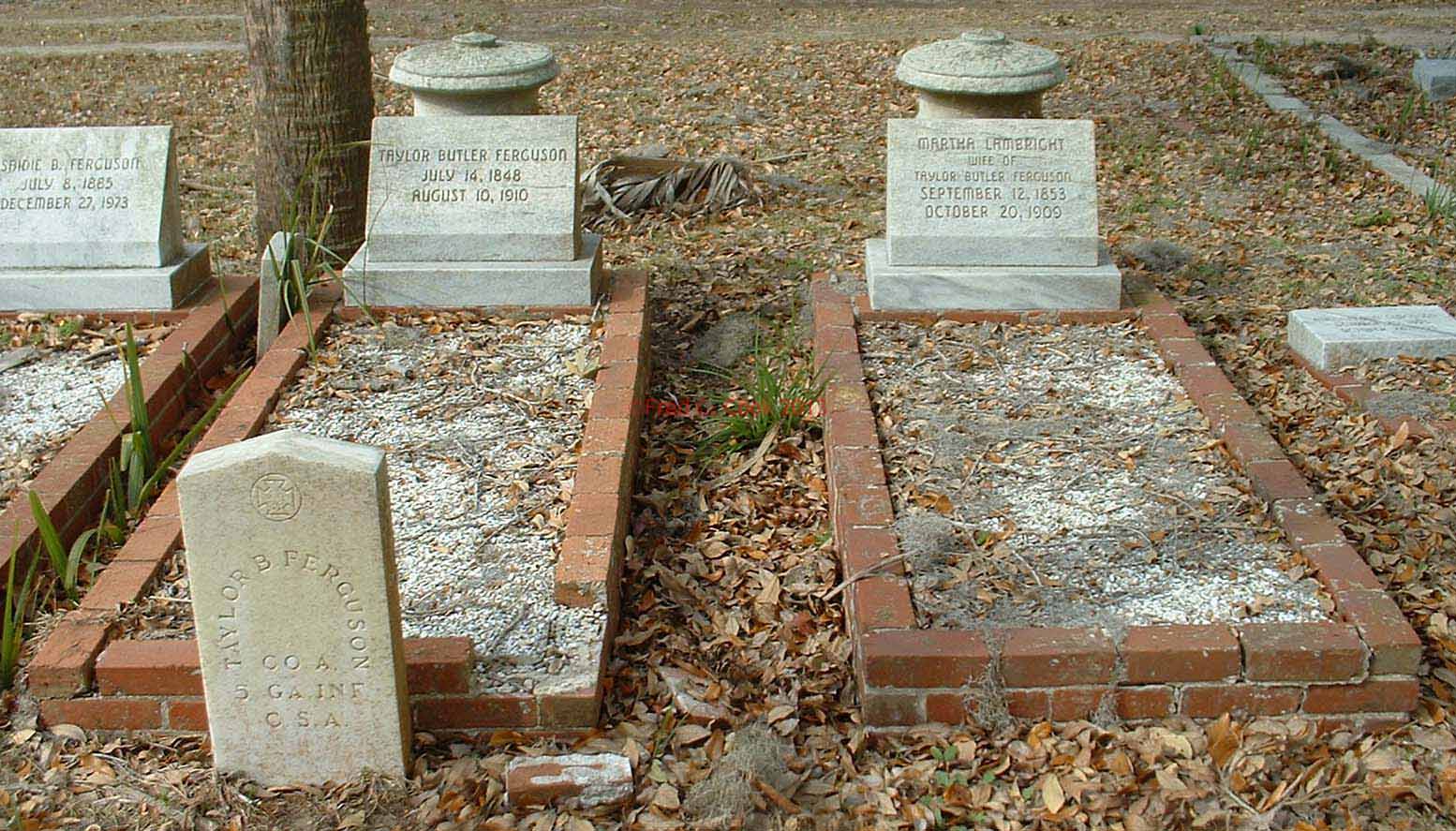
Taylor Butler Ferguson and Martha
Axson Lambright Ferguson in Palmetto Cemetery.
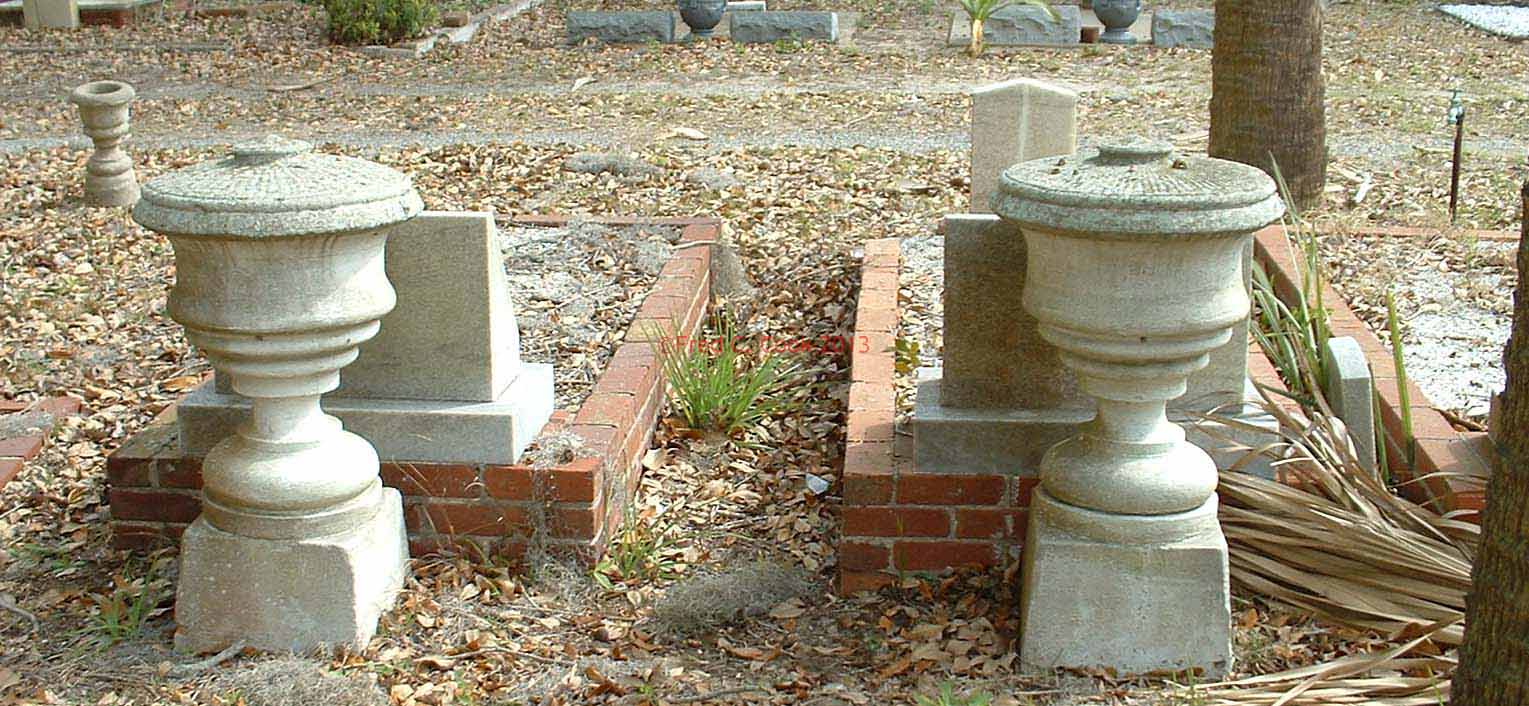
Cast masonry urns made by plastering contractor Taylor
Ferguson.
C.O. Marlin & Company is listed in the
1892 city directory as a “manufacturer of mineral water”.
However, as mentioned above, no bottles bearing the company’s name
are known to exist. Charles Marlin and George
Hodges were the owners of C.O. Marlin
pg. 31 |
|
pg. 32
& Company. Charles Marlin was
living with George Hodges’ family at the corner of
London and Davis Streets in 1892. Their business was located
at 416 Bay Street. It is likely that they were using bottles
from George Hodges’ old Oglethorpe Bottling Works.
You will recall that George Hodges had owned and
operated a local drug store and bottling business several years
earlier. In 1890 Charles Marlin had been working
as a clerk with residence at the corner of G and E (now Norwich)
Streets. By 1896 Charles Marlin was working as a
clerk at Morris Elkan’s dry goods store on Newcastle
Street. There is no further record of C.O. Marlin &
Company and it is assumed that it went out of business shortly after
1892.
William B. Gunby was manufacturing mineral
water at his residence on the corner of G and E Streets in 1892.
Although no street address is given in the directory, the location
has an identical description as Charles Marlin’s
previous residence. It is quite possible that there was some
connection between Gunby’s business and Charles
Marlin. According to the 1892 Brunswick city Directory
William Gunby was also proprietor of a saloon located on
the southeast corner of Bay and Monk streets (300 Bay Street).
Two years earlier Gunby was working as a “dealer in real
estate” and “dealer in sewer pipe, fire brick and building material
generally.” William Gunby’s rapid and drastic
change in business interests is puzzling. No bottles embossed
with William Gunby’s name are known to exist. William
Gunby is not listed in the city directories published after 1892.
Acme Bottling Works The 1896 city
directory lists “Acme Brewing Company” as a Macon, Georgia based
business. An earlier reference to “Macon Brewing Company” was
found in the 1892 city directory. This may have been the same
company, but no bottles are known to bear Macon Brewing Company’s
name. John G. Campbell was the agent for Macon Brewing
Company at 416 Bay Street in 1892. In 1896, Richard V.
Douglas was a wine and liquor dealer located at 206 Bay Street
and the local agent for Acme Brewing Company (see map on page 40).
Richard lived at 607 E Street (Norwich), next to McKendrie
Methodist Church. A final listing for this company is in the
1905 Brunswick City Directory where its address is given as 224-226
Bay Street. This was the site of the old Ocean Hotel (see map
on page 48), which had been torn down and replaced with two brick
buildings between 1893 and 1898. The Acme bottles are of the
soda water type (see bottle on the next page) and the embossing on
them suggests soda contents; therefore the company and their bottle
design are included in the soda section of this book. No other
information pertaining to the company or their products has been
discovered.
L. Markowitz does not appear in the city
directory until 1896, when she is recorded as “Mrs. L. Markowitz
grocer, S. Albany and London.” Lena and her husband
Nathan were German immigrants. Nathan, born in
1872, had immigrated to America first, arriving in 1890. He
returned to Germany to marry Lena in 1893. Nathan
and his new bride sailed to America in 1894. Jake
(Simon) Markowitz, born in 1850, who was probably Nathan’s
father, immigrated to America in 1881. He had been in
Brunswick since at least 1892 and probably encouraged the young
couple to settle there. Jake was a well know saloon
proprietor at 308 Oglethorpe Street in 1892. Nathan was
22 and Lena was 24 when they moved to Brunswick. Census
records indicate that both Lena and
pg. 32 |
|
pg. 33

S104.1 Aqua/ tooled top/ soda/ Hutchinson Stopper
Height- 6 22/32”
Diameter- 2 15/32”
Nathan could read and write English in
1900. Nathan did not waste time becoming involved in
the liquor business. The following article was published in a
local newspaper on August 12, 1894:
“Baumgartner’s
old stand, corner of Monk and Oglethorpe Streets, is being fitted up
as a Saloon. Nathan Markowitz will be its
proprietor. This will make three saloons on that corner.”
The Markowitz’s
grocery store on the corner of London and Albany streets was an “L”
shaped structure. The wing that was parallel to Albany Street
was devoted to the grocery business, while the wing that faced
London Street was used as a dwelling. The 1896 Brunswick City
Directory lists Lena as the grocery store’s owner and
Nathan as its clerk.
Although it has been modified for modern business use, the old
Markowitz structure still stands. The little red building,
shown below in a modern photo, is now an unused commercial
structure. It served as a liquor store in the last half of the
twentieth century and was know variously as “Dixon’s, the “Red Barn”
and later as the “Little Jug.”
Within two years the Markowitz family had moved to a larger
house at 102 E Street (Norwich). At this time Nathan
was manager of the family soda water business that was housed in a
15 by 30 foot building next to their home on the edge of F Street
(see map on page 34). A stable large enough to house a horse
and wagon was located in the northeast corner of the property.
It is interesting to note that all of the soda water bottles used by
the Markowitz business were embossed with Lena’s name,
L. Markowitz.
pg. 33 |
|
pg. 34
The Markowitzs continued to operate their
soda water business into the early twentieth century, at least until
1902. The fate of Nathan’s Saloon is unknown.
Sometime after 1902 the Markowitz family moved to Savannah
where in 1910 Nathan was working as a local salesman for a
Savannah biscuit company. In 1920 Nathan was operating a
gasoline station in Savannah.

Old Markowitz store on the corner of London and Albany
Streets

Markowitz home, bottling house, and stable on E Street in
1898.
pg. 34 |
|
pg. 36
CHAPTER FOUR—BRUNSWICK’S
EARLY TWENTIETH CENTURY SODA BOTTLERS
Louis Ludwig bought Taylor Ferguson’s
soda business in the spring of 1901. Louis was born in
Russia in 1864. His wife Valerie was born in 1863.
They were married in 1891 and immigrated to America in 1892.
The 1900 census indicates that they could read, write and speak the
English language. The Ludwigs did not have any
children. Louis Ludwig’s first appearance in the
city directories is in 1896 when he is listed as: “Grocer- F
Street corner Cochran”. His residence is given as the same
location. By 1898 the Ludwigs had moved their business
to the two story structure on the northwest corner of London and Lee
Streets in “Dixville”; address 1615 London Street. Since in
both directories give their residence at the same address as their
business, it is likely that the Ludwigs, like many other
local grocers, lived on the second floor, above their grocery store.
The Brunswick Call records a strange sequence of
events concerning Ludwig’s Dixville business.
Monday October 17, 1898:
Mr. L. Ludwig has sold out his grocery business on London
Street to Mr. Lazrus who will continue it. Mr.
Ludwig leaves shortly for Jacksonville where he will go into
business.
Monday October 24, 1898:
Mr. L. Ludwig has rented the store recently occupied by
C.J. Doerflinger and will open his grocery business on November
1. Mr. Ludwig will carry a large stock, the main
feature of which, will be his German delicacy department. The
CALL wishes them a success.
Louis Ludwig was back at his old Dixville location
when the 1901-1902 City Directory was published. As mentioned
above, Louis Ludwig bought T.B. Ferguson’s soda
water business in March, 1901. The location of his store was
only 2 blocks from the Ferguson’s home on Cochran Avenue.
On April 18, 1901 he upgraded the newly bought soda business with
100 siphon bottles purchased from American Soda Fountain Company of
Philadelphia, Pennsylvania. In 1902 the Ludwigs were
still manufacturing soda water at 1615 London Street. When the
next directory was published in 1905, the Ludwigs had moved
to 1200 Gloucester Street and there is no further mention of the
store on London Street. Ludwig’s business in 1905 is
listed as “bottling” and he is associated with a Mr. Cline
at 116 Richmond Street as Cline & Ludwig. In
1908 he was an Alderman on the Brunswick City Council and was living
in a nice home at 1607 Union Street. The 1910 U.S. Census
indicates he was employed by a soda water manufacturer. Two
years later he was involved with the Pepsi Cola business at 1410
Oglethorpe Street. In 1920 Louis worked as Brunswick
City Treasurer. The bottles that bear Louis Ludwig’s
name are shown on the next page.
pg. 36 |
|
pg. 37
Brunswick Bottling & Manufacturing Company
appears in the city directory for the first time in 1905. It
was located at 1416 Oglethorpe Street. It is also listed in
the 1908 city directory but not in the 1912 edition. No other
information was found for this company.
pg. 37 |
|
pg. 38

S109.1 Clear/ aqua/ tooled top/ soda/
Hutchinson stopper
Height- 7 1/8”
Diameter- 2 ¼” |
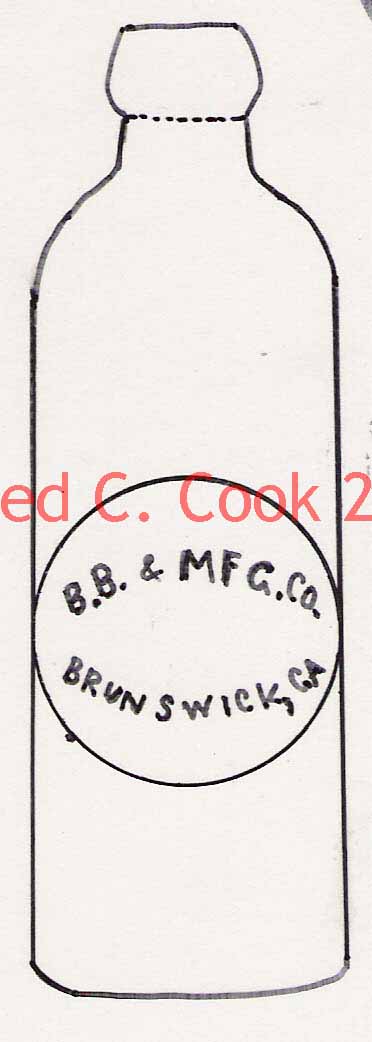
S109.2 Clear/ tooled top
Hutchinson stopper
Height- 7 1/8”
Diameter – 2 ¼” |
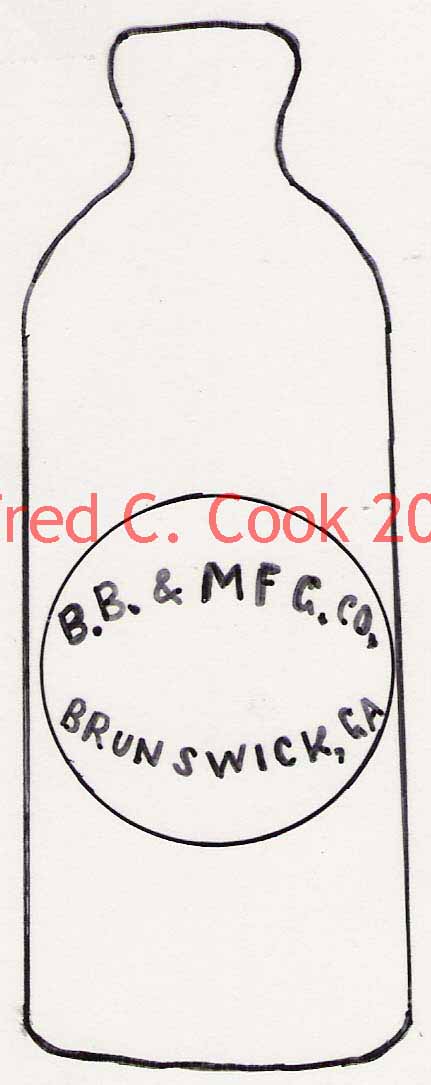
S109.3 Clear/ short/ tooled top/ soda/
Hutchinson stopper
Height- 6 9/16”
Diameter- 2 7/16” |
Brunswick Coca-Cola Bottling Company—1905-present.
This company does not appear in the Brunswick City Directory until
1905. Most of the company’s Hutchinson bottles show little sign of
wear. Because their condition suggests that they were not used for
long, they were probably quickly replaced with crown top bottles.

S110.1 Aqua/ tooled top/ soda/
Hutchinson stopper.
Height- 7 13/16”
Diameter- 2 3/8”
pg. 38 |
|
pg. 39
CHAPTER FIVE—BRUNSWICK’S NINETEENTH
CENTURY BEER BOTTLERS
Benjamin Hirsch was born in Darmstadt, Germany in
1841, of Jewish descent. He immigrated to America in 1860.
He and Elizabeth (Bertha), who was born in Prussia
in1845, were married in 1866. She immigrated in 1865. In
1870 the Hirschs were living in Waynesville about 20 miles
west of Brunswick. The 1870 U.S. Census lists Benjamin
as a “retired merchant” owning real and personal property with
values of $175 and $2000, respectively. Such a status for a 29
year old man was highly unusual during the reconstruction years.
By 1880 the Hirschs had six children, four boys and two
girls. The January 1880 newspaper advertisement shown below
served to notify the citizens of his new general store on the corner
of Bay and Gloucester Streets (also see maps on pages
40
and 41).
Several years later Benjamin and William C. McClure
opened a livery business on Newcastle Street.
|
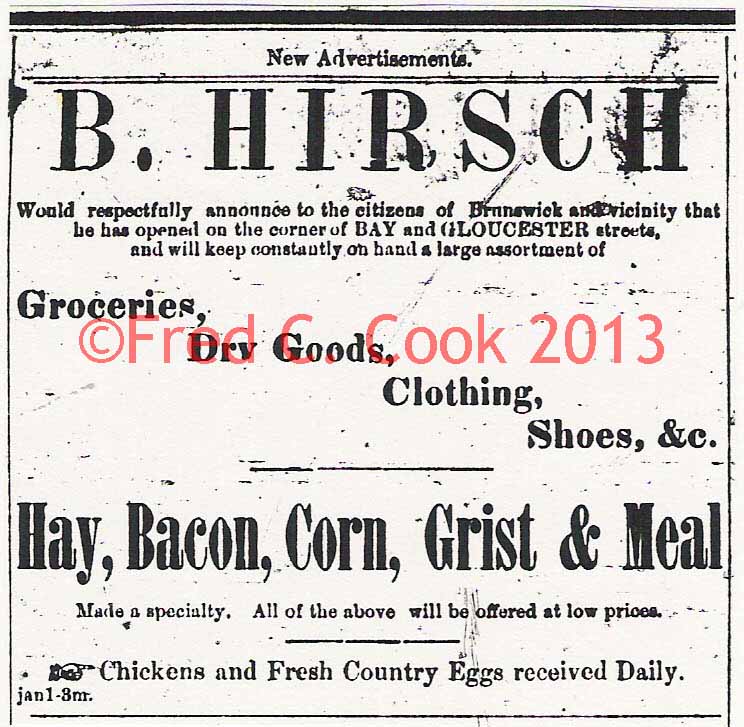
Brunswick Advertiser-Appeal
January 3, 1880.
By 1890 Benjamin had changed his business interests.
During that year and for several years that followed he was a
“Liquor Dealer” at 200 Bay Street, the site of his old grocery
store. The Hirschs resided at 102 Gloucester
Street. The 1893 map on
page 40 shows that their
residence address was on the north side of the building that
housed their “Saloon and Wholesale Liquor” business. The
102 Gloucester Street address was an entrance on the north
side of the liquor store (see map page 40). This
entrance provided access to a staircase that led to the
Hirsch’s residence on the second floor. |

December 2, 1882 |
pg. 39 |
|
pg. 40
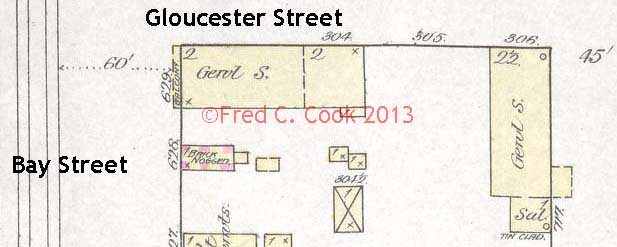
1885 Sanborn Fire Insurance Map showing B. Hirsch’s 2 story
wood-framed
General store and dwelling on the corner of Gloucester and Bay
Streets.
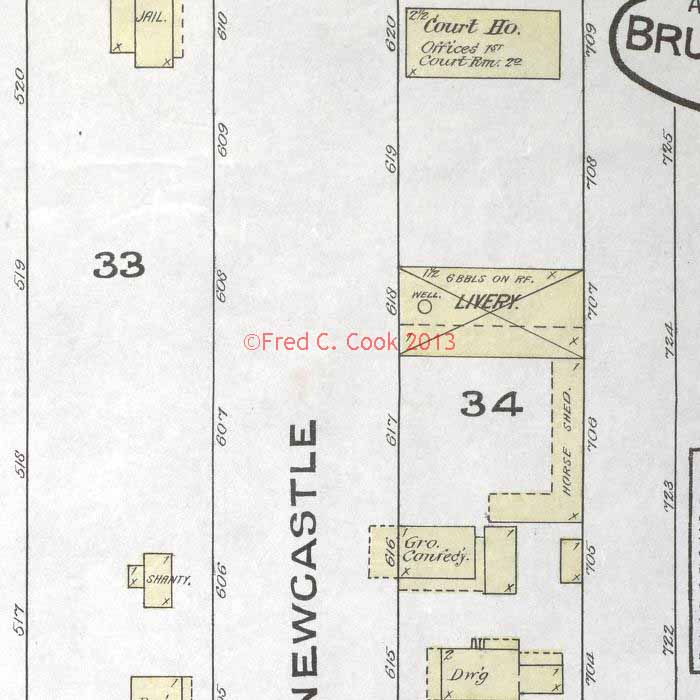
1885 Sanborn Fire Insurance Map showing Hirsch & McClure
Livery Business on Newcastle Street.
Note the well located in the front of the main livery building.
pg. 40 |
|
pg. 41

Modified (modifications in block letter type) 1893
Sanborn Fire Insurance Map illustrating
various businesses along the west side of the 200 block of Bay
Street.
Yellow structures are wood framed, pink are brick and gray indicates
sheet metal clad.
Note discrepancies in street addresses south of F.M. Scarlett.
Certain differences exist between business addresses given on the
Sanborn maps and the Brunswick city directories. The maps
provide information on the types of businesses present in certain
structures, but they do not usually provide the names of the
occupants. An attempt has been made to correlate several
businesses and their addresses listed in the 1892 city directory
with the 1893 maps shown above. Going south from B Hirsch’s
business on the corner of Bay and Gloucester Streets, the initial
discrepancy seems to occur at 210 Bay Street. The map and
directory addresses agree as far south as F.M. Scarlett’s
liquor business, but the Briesenick foundry which is listed
as 210-214 in the 1892 directory does not agree with the address of
212-216 given on the map. This discrepancy continues through
the 1908 map when all of Brunswick’s N-S addresses
pg. 41 |
|
pg. 42
were changed. References to this
discrepancy will be made in discussions of businesses south of
Briesenick Foundry and Machine Works.
The Hirschs had six children, but one, Robert, died at
the age of 16. Two of the three surviving boys entered the job
market at early ages. In 1890, the oldest boy Moses
(called Mose) was working as a clerk for S.W. Apte
Clothing Merchant at 216 Newcastle Street. The same year,
Henry, age 15, was working as a clerk for Kaiser Brothers
Clothing Merchants at 120 Newcastle Street. Two years later,
Mose was working in his father’s liquor store. In 1892
the child labor laws were not as strict as they are today and
Jacob D. (Jake), then only 12, was also working as a
clerk in the liquor store. The Hirsch’s daughter
Emma married Julius May, a future liquor dealer at
200 Bay Street.

Brunswick Times Call
January 15, 1894.
The newspaper advertisement above shows that by 1894 Moses
Hirsch and his father were operating separate liquor businesses.
It also documents the fact that the day of locally bottled beer was
over. On April 2 of the same year the following article
appeared in the Police Notes section of the paper:
Officer Lofton went to Everett City Saturday night
to arrest G.W. Miller, charged with cheating and swindling
Mose Hirsch, the liquor dealer. Not finding his
man, Officer Lofton returned to town and made a
thorough search about the city for him. Miller, however
had disappeared.
pg. 42 |
|
pg. 43
In 1898, young Henry Hirsch was working as a bartender
for his brother-in-law Julius May, who operated liquor
businesses at 210 Gloucester Street and 200 Bay Street, the old
Hirsch store. As detailed above, the May and
Hirsch families were connected by marriage and Benjamin,
then 57 years old, may have become tired of the liquor business,
leaving its operation to his son-in-law and son. However,
Benjamin continued to work for at least ten more years. In
1910 he was working as a merchant in Brunswick with his son Jack.
In his old age Benjamin moved to Los Angeles, California to
live with his oldest daughter Adaline and her husband
Herman Harris. He died there in 1928 at the age of
87.
The process of bottling beer that was used by Benjamin and
other local bottlers was relatively simple. Merchants bought
15 or 30 gallon kegs of draft beer that were shipped in refrigerated
boxcars. During the filling process the bottles had to be
cooled to keep the contents from foaming over. Otherwise, the
bottles were easily filled directly from the keg tap. It is
not likely that the bottles of beer were pasteurized or “steamed”;
therefore, they would have to be kept on ice until they were
purchased. The bottle shown below, which dates to the late
1880's, is the only type of beer bottle known to have been used by
Benjamin Hirsch:
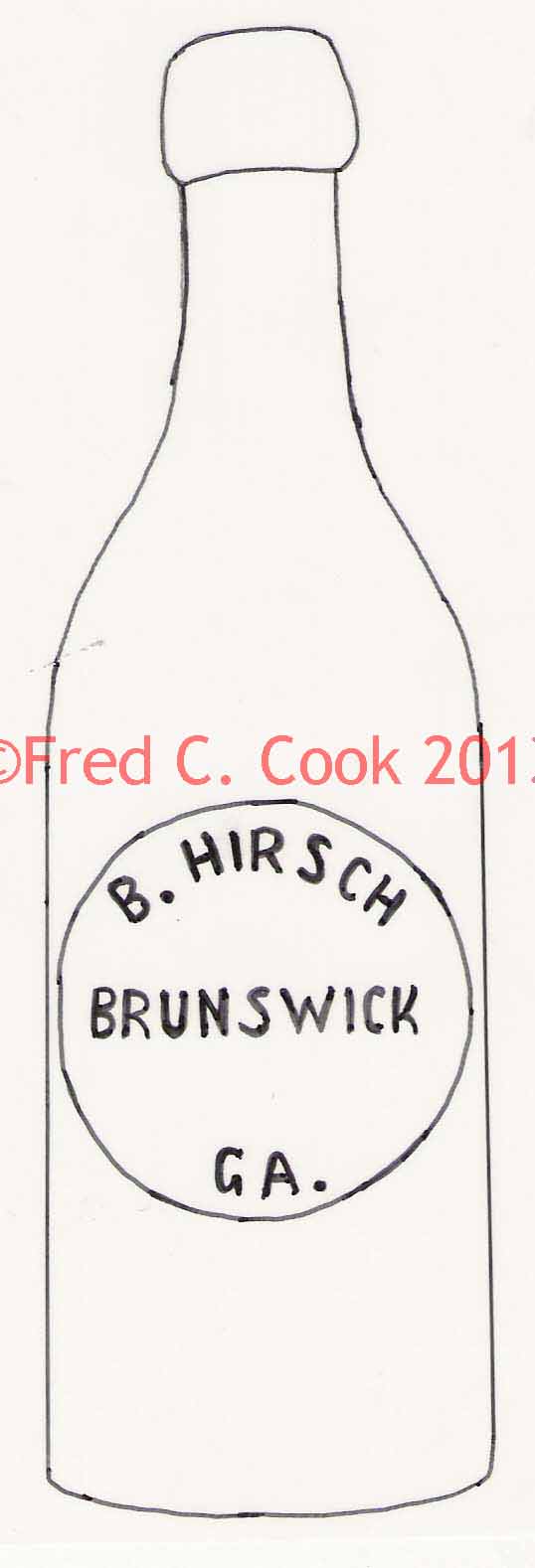 |
B104.1
Aqua/ applied top/ beer/metal cap Lightning Stopper.
Height- 9 5/32”
Diameter- 2 ¾” |
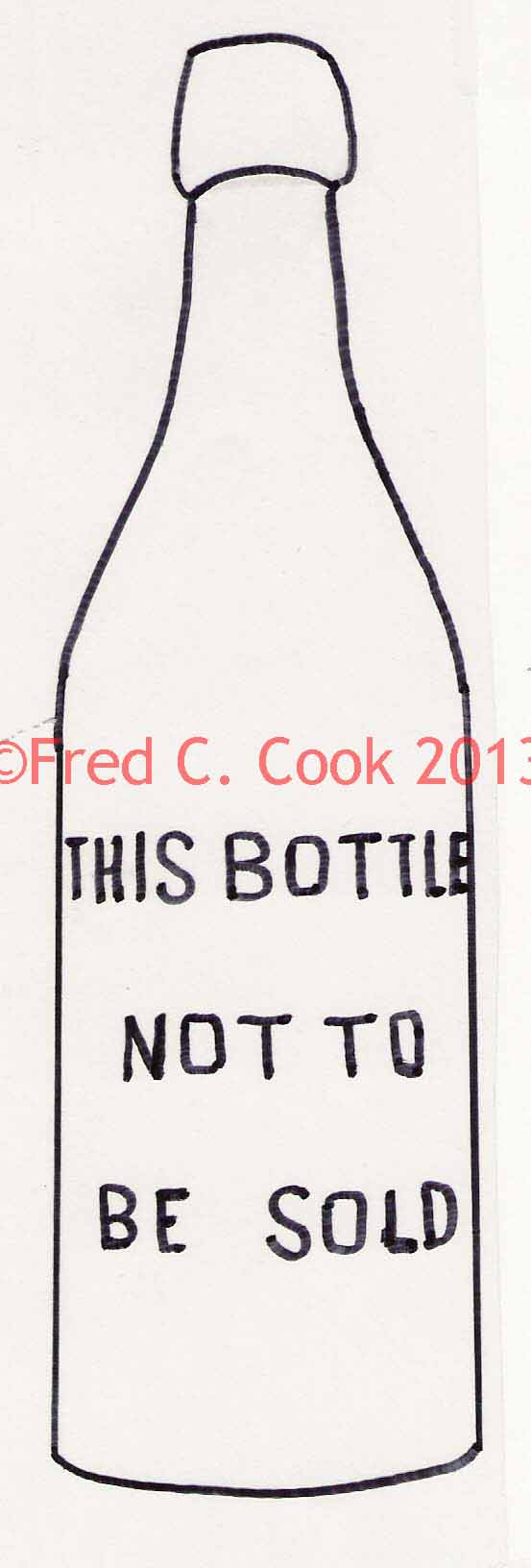 |
Robert Stuart Grier was born on December 29,
1850 in Burlington, Vermont. His parents were Thomas J.
and Maria Clark Grier, who were both Irish
Immigrants. Robert and Annie Maria Fee,
who was 14 years younger than him, were married in 1896.
Annie’s parents were also Irish. The Griers had
three daughters and one son, Robert, Junior. In
the 1873-1874 Columbus City Directory Robert was listed as a
salesman for J.J. Kaufman merchant. That same year
Robert’s father was working as a mason and stone cutter.
The next directory, 1878-79, indicates that Robert was a
travel agent living with
pg. 43 |
|
pg. 44
his mother at her Grocery store at 56 Troup
Street. During the years 1880-81 Robert was still
working as a travel agent. There is no listing for Robert
in the 1884-85 directory, but from about 1886 until 1889 he operated
a one story, wood framed grocery and saloon at 701 Third Avenue (see
map below). He lived in the attached dwelling at 703 Third
Avenue. His recently widowed mother was boarding with him (Thomas
Grier died in 1885).

Copy of 1895 Sanborn Insurance Map showing Robert
Grier’s residence and general merchandise store in Columbus.
Location is 701 Third Av. Note bucket well in the back yard.
Sometime between 1889 and 1890 Robert Grier and
Tobias Newman (See next section) moved to Brunswick.
One source suggests that Grier and Newman came to
Brunswick to establish an ice business. However, their bottles
indicate that they developed a partnership in the liquor and beer
business. This business must have been short lived because
when the first Brunswick city directory was published in1890, both
men had gone their separate ways, each owning competitive liquor and
beer businesses on Bay Street. During that year, Robert
was a “dealer in beer, liquor etc.” at 204 Bay Street (see map on
page 40). His business was in the northern one-half of a new
brick building with a former address of 626-627 Bay Street.
Robert and Tobias both lived at the Ocean Hotel on Bay
Street in 1890 (see map on page 48). The only listing for
Robert Grier is in this directory and it is assumed that
he returned to Columbus between 1890 and 1892, when the next
directory was published.
Robert Grier appears in all of the U.S. Censuses from
1900 through 1930. During those years he worked as an
insurance agent and lived at 213 Seventh Street and later at 634
Broad Street in Columbus. Robert Grier died on
April 14, 1932 at the age of 81. His obituary follows:
pg. 44 |
|
pg. 45
ROBERT STUART GRIER, Sr.—Born
Burlington, VT., Son of THOMAS J. GRIER, native of Dublin,
Ireland, & MARIA CLARK GRIER, leaves wife,
Mrs. ANNIE FEE GRIER, 1 son, R.S. Jr.,
3 daughters, Mrs. ROBERT RYAN of Montgomery, Ala., MRS.
FLOURNOY HAMBURGER & MRS. HENRY BRAY, both
of Columbus, GA., 2 sisters, MRS. JOHN CONNERS of Montgomery,
Ala., MRS. H.E. HALL of Columbus, GA., 3 grand sons, 5
grand daughters.
Robert Grier’s bottles are shown below. He is
buried in Lot 185 of Linwood Cemetery in Columbus, Georgia.
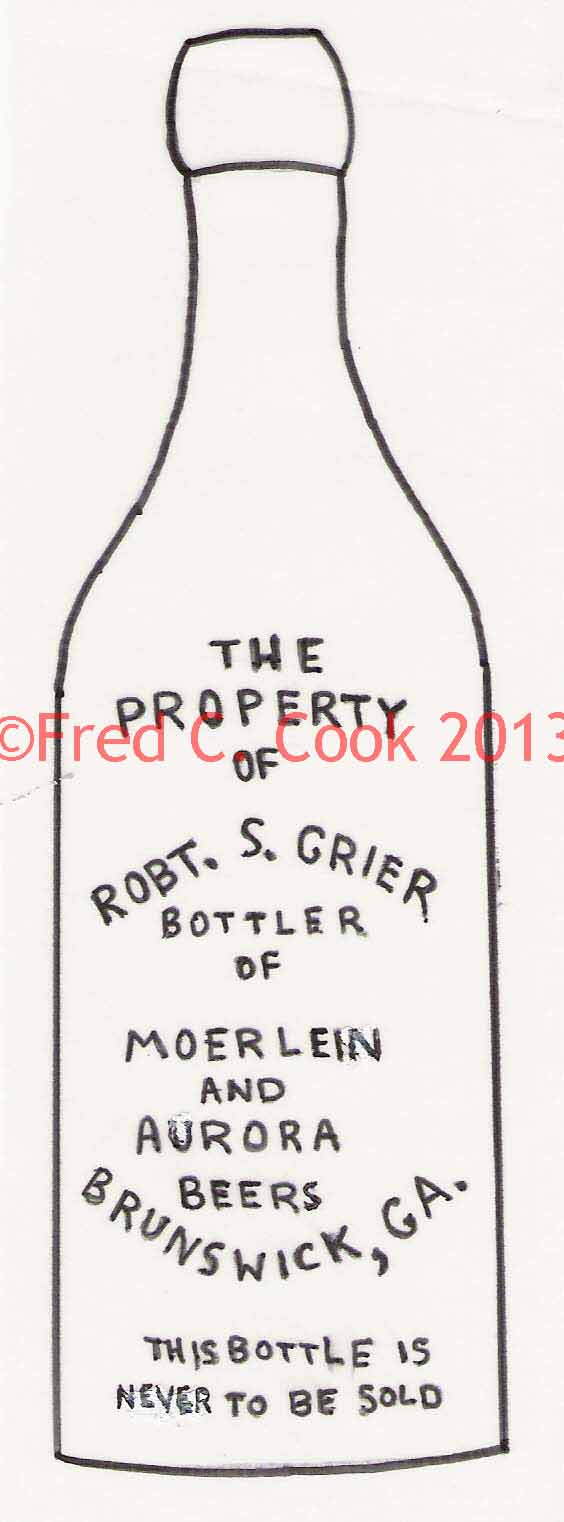
B102.1 Aqua/ applied top/ beer/metal cap Lightning Stopper.
Height- 9 7/16”
Diameter- 2 13/16” |


B102.2 Aqua/ applied top/ beer/metal cap Karl Hutter
Lightning Stopper/ “ Karl Hutter New York” embossed on base of
bottle.
Height- 9 3/16”
Diameter- 2 13/16” |
pg. 45 |
|
pg. 46
|
 |
B102.3 Aqua/applied top/beer/
metal cap Karl Hutter Lightning
Stopper/Height- 9 3/8”
Diameter- 2 11/16” |
 |
Newman & Grier is a poorly documented
partnership. As mentioned above, Tobias Newman
and Robert Grier moved from Columbus to Brunswick
about 1889. Apparently, they were in business together briefly
and then dissolved their partnership sometime before 1890, when they
were operating competitive businesses (see their bottles below).
Unlike Robert Grier, who returned to Columbus,
Tobias Newman remained in Brunswick until his death in
1914. Apparently, Tobias retained possession of the
bottles and continued to use them for a number of years.
 |
B101.1
Aqua/ amber (rare) applied
top/ beer/metal cap Lightning Stopper.
Height- 9 1/8”
Diameter- 2 11/16” |
 |
pg. 46 |
|
pg. 47
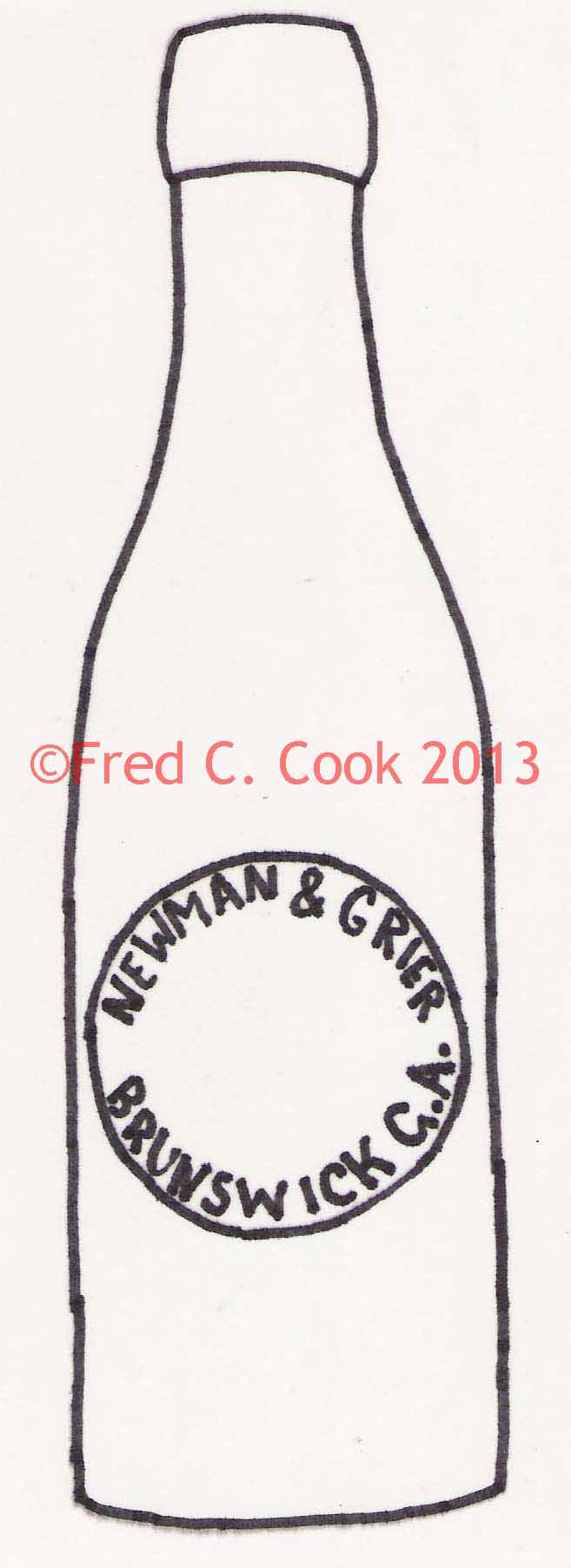 |
B101.2
Aqua/ applied top/ beer
Height- 8 3/16”
Diameter- 2 5/1 |
 |
Tobias Newman (“Capt. Tobe
Newman”) was born in 1846 in Bremen or Hanover, Germany.
His exact birthplace is uncertain because both cities are credited
in the U.S. Census records. Bremen and Hanover are relatively
large cities about 100 miles apart in northern Germany. In
fact, Tobias may have been born in a rural area somewhere
between these two cities. He married Jane (Jennie)
Evans in 1869. Jane, who was born in 1848 to
Irish parents in Florida, was two years younger than Tobias.
They had ten children, of which eight were surviving when he died in
1914.
In 1870, the Newmans were living in Columbus, Georgia and
Tobias was working in, or owned, a local saloon. The first
Columbus City Directory listing for Tobias was in 1878-79,
when he was operating a saloon at 58 and 60 Broad Street in
Columbus. He was in the saloon business in 1880-81 with W.J.
Coffield (T. Newman & Company) at 52 Broad Street (see
map on page 48). However the 1880 census credits him with
being an ice dealer. In 1884-85 he was operating a restaurant
and saloon, no location given. During this time he was living
at 83 North Jackson Street. In 1886-87 Tobias’ business
was “fish and saloon” at 1214 Broad Street. He was then living
at 1420 Second Avenue. The last Columbus listing for Tobias
was in 1888-89 when he operated a “Saloon Restaurant” and was the
agent for “Crescent Brewing Company” at 1214 Broad Street. He
was still living at 1420 Second Avenue.
By 1890, when the first Brunswick city directory was published,
Tobias had moved to Brunswick and was living at the Ocean Hotel
on Bay Street (see map on page 49) with his oldest son George.
Because of their residence in a hotel, it seems likely that Jane
and the younger children remained in Columbus for several years.
In 1890 Tobias was a” beer bottler” at 216 Bay Street, only 6
doors south of his former partner, Robert Grier.
By 1892 the rest of the Newman family had moved to Brunswick
and they were residing on the southwest corner of K and D Streets.
This house has been variously listed
pg. 47 |
|
pg. 48
with changing street address systems as 526 D
Street and 2078 Ellis Street (see map on page 50). The 1892
Brunswick city directory lists Tobias Newman’s
business as” wholesale and retail liquors 216-218 Bay Street”.
The 1893-1908 Sanborn maps show this 2 story building with a brick
first story and wooden second story.

1885 Sanborn Fire Insurance map of Columbus, Georgia
showing former locations
of Tobias Newman’s businesses at 52 and 58 - 60 Broad
St.
The map on
page 49 assigns Tobias’
business with what is presumably an incorrect street address of
218-220. This error was explained on
page 41. The fact
that this location was a vacant lot on the 1889 Sanborn map
indicates that the brick building was built between 1889 and 1890,
when the northern one-half was occupied by Tobias’ liquor
business. George R. Newman, who was 22 years
old, was a clerk at his father’s business in 1892. In 1896,
Tobias is credited with operating a saloon, later called the
Metropolitan, at 216 Bay Street. In reality, the saloon
occupied the southern one-half of the building which was 218 Bay
Street. The saloon’s business address may have been the same
as the liquor store, but the 1893 and 1898 Sanborn maps clearly show
the liquor store in the northern part of the building and the saloon
in the southern part. In 1896 the Newman’s residence
was at 526 D Street, which is the same location as their 1892
address. By 1896, George Newman, then 26 years
old, was managing the Metropolitan, which had been formerly managed
by A. Hepp. The 1898 Brunswick city directory indicates
Tobias was in charge of the saloon again assisted by
George, who worked as a bartender. Tobias also
worked as a “brewery agent” at 206 Bay Street, possibly for Acme.
Tobias continued to operate
pg. 48 |
|
pg. 49
the Metropolitan saloon throughout 1902. He
lived at 2028 Ellis until his death on March 27, 1914. In
spite of his interest in the “spirits” business, Tobias
Newman was an important and well loved citizen.

Modified (bold typing) 1893 Sanborn Insurance Map
showing businesses on the southern end of the 200 block
of Bay Street. Note that the correct addresses of Tobias
Newman’s building, as for the Briesenick Foundry,
are two digits lower than those shown on the map.
pg. 49 |
|
pg. 50
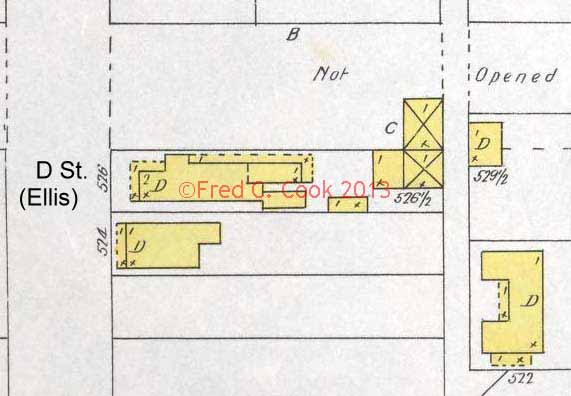
Modified (bold typing ) 1898 Sanborn Fire Insurance
map showing Tobias Newman’s house
at 526 D Street (later 2028 Ellis St.). Note stables (keyed
with an X) on the lane behind the house
and possible attached servant’s quarters .
|
 |
B103.1 Clear/ tooled top/
Lightning Stopper.
Height- 9 3/16”
Diameter- 2 11/16” |
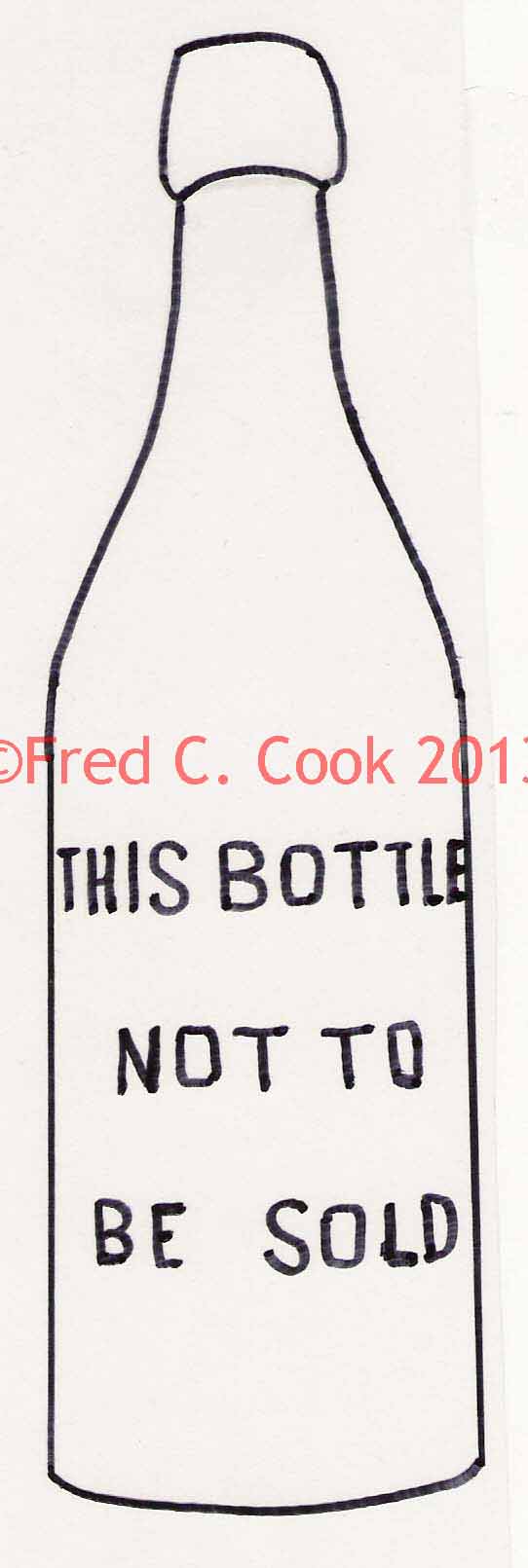 |
pg. 50 |
|
pg. 51
Tobias Newman’s obituary tells much about his
personality and life in Brunswick:
The Brunswick News March 28 (Saturday),
1914:
CAPT. T. NEWMAN PASSES TO REST FUNERAL; SUNDAY—PROMINENT
CITIZEN DIED AT HIS HOME AFTER A SHORT ILLNESS—THE
END CAME LAST NIGHT—Capt.
Newman Had Long Been Identified With Brunswick’s Business
Interests—Was
at Present a Member of City Council.
After an illness of just ten days, Captain Tobias
Newman, one of Brunswick’s best known and most prominent
citizens, passed away at his home on Ellis Street last night at 9:15
o’clock. Captain Newman suffered a stroke of
paralysis during the early part of last week, and for the first two
or three days his condition was considered serious. During
that time he was unconscious, but later he regained consciousness
and seemed to improve and sincere hope was then held out for his
recovery. A few days ago, however, he suffered a relapse and
since that time he has been lingering between life and death with
all hope of an improvement abandoned. Out of town members of
his family were summoned to the city, and most of them were at his
bedside when the end came last night.
“Capt. Tobe,” as he was familiarly known among
hundreds of friends in Brunswick, was one of the city’s best known
and most energetic citizens. During all of his long residence
here he has at all times had the interests of Brunswick at heart and
has in every way rendered all the assistance that he could in the up
building of the city.
Captain Newman has served Brunswick and Glynn County
in many positions of honor and trust and he has on every occasion
fitted this with ability. He was a member of the city council,
being one of the representatives of the fourth ward. He had
previously served as a member of the council, and in all of his
years as a city solon he has worked hard and faithfully in the
people’s interest. As chairman of the public works committee,
he personally looked after all of that department of the city,
devoting most of his time to the work. He was one of the best
known Knights of Pythias in the State of Georgia and for many years
was the commanding officer of the local uniform rank, where he
justly gained a reputation as one of the best drill masters in the
country. On numerous occasions he went to prize drills in all
sections of the country at the head of the local company and
returned with first prize; not only for capturing the trophy for his
company, but, on one or two occasions, himself winning the first
prize for the best drill master.
In his death Brunswick loses one of her best and most valuable
citizens. Though somewhat advanced in years, Capt.
Newman was active in life until he was stricken a short time
ago.
The deceased is survived by a widow and eight children, as follows:
Geo. A. Newman, of Jacksonville; Walter, Eberhardt
and Bernard Newman, of this city; Mrs. J.W. Abbott,
Mrs. J.I. Latham, Mrs. Colson Hoyt, of this city, and
Mrs. Maggie Joiner, of Hazlehurst.
The funeral arrangements will be completed today and beyond the fact
that interment would take place Sunday no further announcement was
made last night.”
pg. 51 |
|
pg. 52
It is interesting to note that Tobias Newman’s
business interest in “spirits” is not mentioned in his obituary.

Tobias Newman’s
grave in Palmetto cemetery. Note Knights of Pythias symbols
carved into his marble slab.
pg. 52 |
|
pg. 53
Charles Fruend Agt.—Charles
Freund (note spelling error on bottle) does not appear in any
of the Brunswick city directories and it is assumed that the had
died or moved away by 1890. Two mortgage documents involving
Charles Freund were found in the Glynn County
Courthouse. The first, recorded on December 14, 1888 was in
the form of a loan from J.S. and A.D. Schofield to
Charles Freund and G. Lowinstein presumably to
secure funds to start a business. The second involves an
agreement between Charles Freund and Rosendo
Torras & Company in which he leases water front lot 49 on the
south end of Bay Street for the purpose of establishing a “Wood and
Coal Yard”. Water lot 49 was on the north end of the
Rosendo Torras Lumber Yard. One small “L” shaped
wood framed structure with front and back porches and a sheet metal
roof occupied the site. The embossing on his beer bottles
suggests that he may have been a local agent for a northern or
Midwestern brewing company.
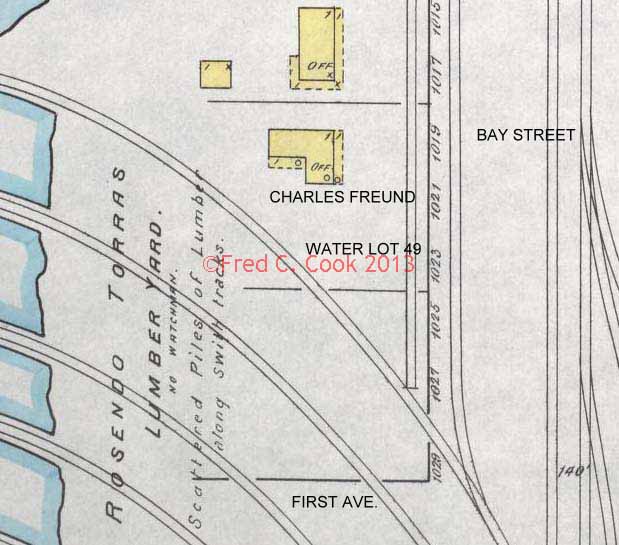
Modified (bold type) copy of 1893 Sanborn Insurance
Map showing Charles Freund’s
business on Water Lot 49.
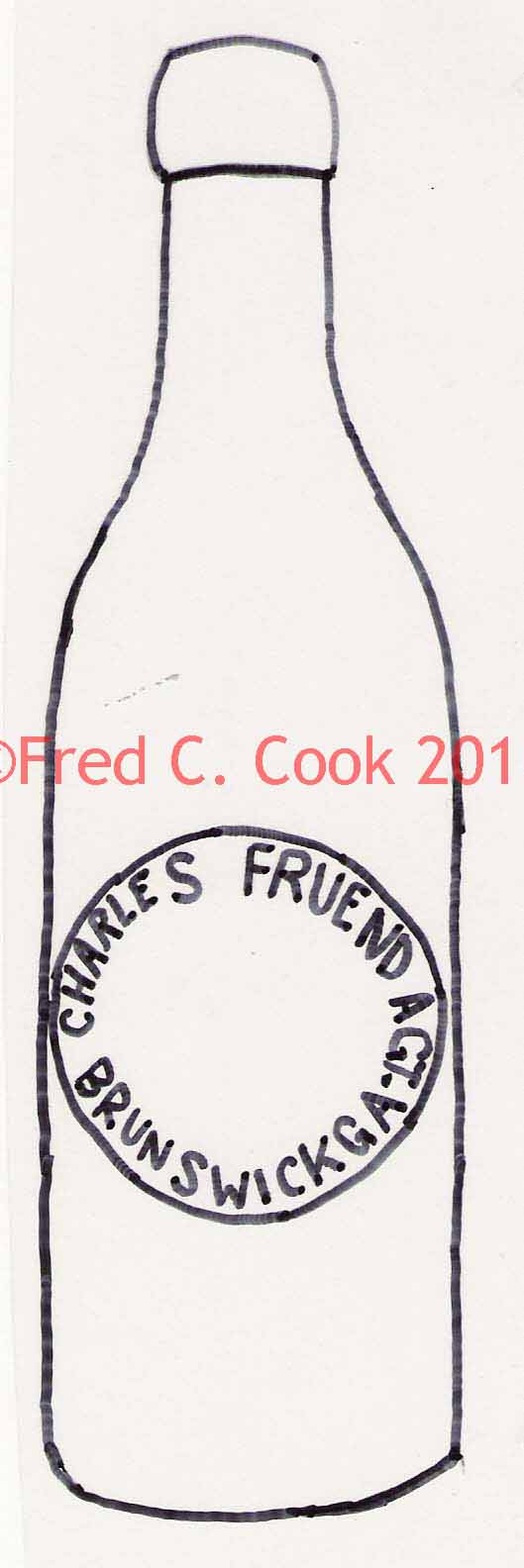 |
B105.1
Aqua/ applied top/ beer/ metal cap
Karl Hutter Lightning Stopper/
“VI. N/ K. Hutter/ N. Y.” embossed
on base of bottle.
Height-9 5/16”
Diameter-2 11/16” |
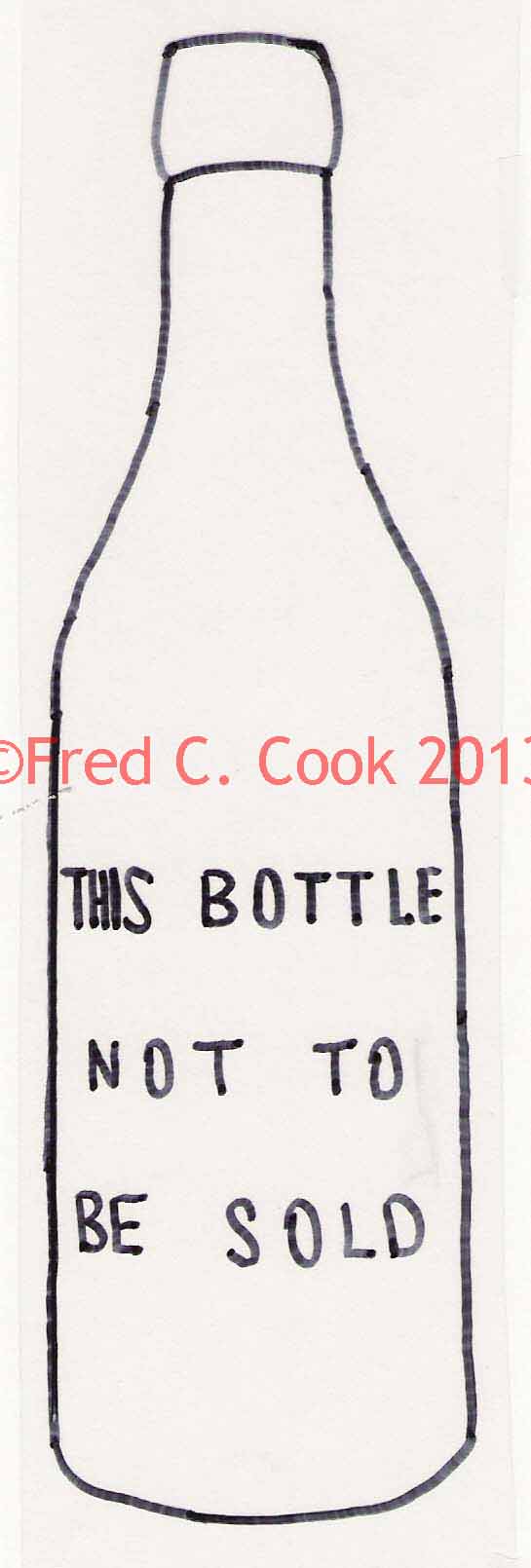 |
pg. 53 |
|
pg. 54
Brunswick Brewing & Ice Company—On
Thursday September 19, 1889, the following article was published in
the Brunswick Daily Advertiser-Appeal:
Brunswick to Have an Ice and Brewery
Plant.
For some time past different men have had their eyes on
Brunswick as a favorable place for a brewery plant.
None so far have taken shape until now. Today we have
among us Mr. P.H. Wolters, of Philadelphia, who
comes here to locate an ice and brewery plant. Just
as soon as he locates the site he will give out the
contract for all of the buildings.
CAPACITY
The ice machine will have a capacity of forty tons per
day- sufficient ty [to] supply not only all they need
themselves, but the wants of the city and surrounding
country besides.
The brewery will have a capacity of 50,000 barrels, and
employment will be given to about two hundred hands.
$100,000
From Mr. Wolters we learn that the
cost of the plant will be $100,000, all of which stock is
now being taken and the money deposited ready to pay all
contracts.
It may prove of interest to our readers to state that the
first beer ever brewed in Georgia was brewed on Jekyl
Island by Major Horton under the direction
of General Oglethorpe. The hops were
raised on the north end of the island, and the beer made
on the same place. the old well is still there where the
water was gotten that was used in the manufacture.
It stands just on the bluff of the creek, and rises and
falls with the flow of the tide; but it does not
pg. 54 |
|
pg. 55
|
partake of salt. It is as sweet and
and nice today as it was one hundred years ago, when first
used.
Mr. Walters [sic] has been looking for some time for a
good place to erect his works, and finally selected Brunswick
over Savannah, Charleston, Jacksonville and Wilmington.
The point selected is the strip of ground between the
boulevard and the railroad, where the two cross each other on
the eastern side of the city, and on the east side of the
track.
Besides the brewery and ice machinery, the company will erect
a cold storage warehouse similar to those used in western
packing houses. There will be the first houses erected
on the boulevard proper. We expect to see scores of
other building front upon the same in the next decade. |
 |
The investor’s dreams soon came to fruition. By 1892, when it
is advertised in the Brunswick city directory, Brunswick Brewing &
Ice Company was fulfilling local needs for ice, beer and soda water.
It is unknown, if Mr. P.H. Wolters actually sold the
machinery from his Philadelphia Brewery to Brunswick business men or
not. He certainly sold his Philadelphia beer bottles to the
Brunswick business. Many of these bottles have been found
locally. An example of his Baltimore loop seal bottle is shown
above. Within a year he has become associated with
XXXXXLocal business and banking
magnate Max Ullman served as the Company’s President
and Treasurer, while Rudolph H. Stahl was its
secretary and on site supervisor. Because the plant was
located in the southern part of town, the soda, beer and ice
distribution centers were several miles to the north, in the heart
of town and close to the railroad platforms. The map on
page
41 shows the location of “Lofton & Miller” (Wm. P.
Lofton and Herbert A. Miller) Brunswick Brewing & Ice
Company’s “agents for beer and mineral water” at 202 Bay Street.
At the same time Frank Langley was manager of the ice
department at 321 Newcastle Street.
The detailed Sanborn map of the company’s Albany Street facility
shows that the East Tennessee, Virginia & Georgia Railway delivered
the “imported hops and Canadian malt” and the coal needed to fire
the steam boilers directly onto the plant’s side track (see page
56). With the exception of the boiler and pitch kettle
supports, the buildings were wood framed. The cold storage,
bottling house, ice machine and dynamo building and part of the
stable were clad with sheet metal. Saw dust was probably used
as insulation within the walls of the cold storage and ice machine
buildings. The contents and operation of the plant in
relationship to this map and the Artesian Ice & Manufacturing
pg. 55 |
|
pg. 56
Company document were discussed on
pages 8-10;
therefore, they will not be elaborated on again here.

Brunswick Brewing & Ice Company as it appeared on the
Sanborn Fire Insurance map published in April, 1893. Crates
and bottles were probably kept in the open shed.
Structures marked “D” (Nos. 5-7) were used as housing for plant
workers (see
page 57).
pg. 56 |
|
pg. 57

The advertisement shown above lists three types of beer produced by
the brewery. Pilsner is a beer with a strong hop flavor that
was first brewed in the 1840's in the town of Pilsen (modern Czech
Republic). It is a golden lager that replaced the dark sweet
traditional beers of the region. It is made with pale, lightly
roasted malt that produces a beer with a straw like or golden color.
Kaiser beer was, and still is, Austria’s leading beer brand.
It is described as a lager beer with a prodigious frothy white head
that fits somewhere between an amber bottom fermented Munchen beer
and a golden Czech Pilsner. Cloister beer is a term for a
German beer (Kloster bier) that was produced in Monasteries or
Convents. No physical description was found for this beer.
A list of plant employees as they appeared in the 1892 Brunswick
city directory follows:
1) STAHL RUDOLPH H, sect’y
BRUNSWICK BREWING & ICE CO, office at Brewery, h (house), S Albany
st. near Boulevard and Brewery.
2) Henry Black, c lab Brewery, h at Brewery.
3) James Clubb, emp Brewery, h 606 C St
4) Henry Dawson, c, lab Brewery, h at Brewery.
5) Luke Dawson, c, lab Brewery, h 304 N Cochran Ave.
6) William Dorsey, c, lab Brewery, h at Brewery.
7) Wm. Garvin, bottler at Brewery, h do (same location).
8) Herman Greenidge, brewer, h at Brewery.
9) Frederic Hubach, master brewer Brewery, h at
Brewery.
pg. 57 |
|
pg. 58
10) George Moore,
c, lab Brewery, h 822 Egmont St.
11) A. Newman, c, fireman Brewery, h at Brewery.
12) John Ogren, lab at Brewery, h cor F and D Sts.
13) Charles Plumb, c, drayman Brewery, h at
Brewery.
14) Charles Smith, lab Brewery, h 1207 3d
Ave.
15) Grover E. Summerall, emp Brewery, h 504 S. Cochran Ave.
16) David Waltower, c, fireman Brewery, h 706
S. Amherst St.
17) Wm P Lofton, (Lofton& Miller) agt. Brunswick Brewing &
Ice Co.202 Bay st, h 1107 S Wolf st.
18) FRANK LANGLEY, mgr. ice dept. BRUNSWICK BREWING
& ICE CO 321 Newcastle st, h 1109 S Wolf st.
19) John P Jardine, engineer at brewery , h 1205 S Wolf st
20) Herbert A Miller, (Lofton &Miller) agts beer & mineral
water dept Brunswick Brewing & Ice Co 202 Bay st, h 1107 Wolf st
21) Wm Potter, c, cooper brewery, h at Brewery.
Nine of these twenty-one 1892 Brewery workers lived in the five
plant site dwellings. Two of these dwellings were duplex units.
Six of these workers were black and three were white.
Unfortunately for the investors, this business was to have a short
life. The small population of Brunswick and the Golden Isles
was not able to generate an adequate market for the products of such
a large facility. Within a few years the plant was in a state
of financial ruin. Another factor that may have influenced the
demise of this enterprise was the competition created by the large
Midwestern breweries, which were beginning to produce and bottle
high quality pasteurized beer in addition to their traditional
barreled product (see
advertisement on page 42). Not only was their pasteurized
bottled beer consistent in quality, but it had a long shelf life
that required no refrigeration. This property allowed the beer
to be shipped across the nation to consumers in no-return bottles;
therefore avoiding the excessive costs associated with the
traditional return, wash and refill bottles. Glynn County
records contain a lengthy and informative document which details the
financial collapse of Brunswick Brewing and Ice Company in 1895,
when it was transferred in receivership to The Artesian Ice and
Manufacturing Company. This company was apparently set up to
dispose of the property, buildings and mechanical equipment at the
brewery. Consequently, it is never advertised as a functional
business. The portion of this document, reproduced below,
gives a detailed list of the buildings and equipment. These
records are reproduced below in script similar to that in which they
were recorded.
Book QQ page
16: * Line format as
originally written script.
….. *Also
the following described
buildings, erected upon the above described property, to-wit:
Brewing House three stories high 30X40; Vault and Store house
for beer with hop room and office in front 22 X 165 feet, Bot-
tling house and utensils 40 X 100 feet; Ice store house 40 X 50
feet, machine room and boiler house 40 X 80 feet; six dwelling
pg. 58 |
|
pg. 59
houses; stable for
twelve horses.
Also the following
described property
situated in the buildingsand upon the land hereinbefore set
out, to-wit:
Two 100 Horse power
Boilers, Two Heaters and
water refiners for Boilers, one Edison incandescent Electric
Light Plant 90 C. P. Capacity; one office desk and shelving
one Marvin Fire Proof safe, Fixtures of Office, Two tables
six chairs, one copying press, Large picture of Gambrinus*. Eight
(See
page 61)
Patent fans and Connections with beltings, one corking
machine. One air pump, one filling machine with
changes.
wash rinder and tap. One small engine with water spigot
pipes, shafting and belting and connections, two endless chains,
blocks and pulleys, four wood tubs and utensils of bottling house.
One
patent Zwietish filter* and machinery thereunto belonging, one
(See
page 10)
large copper cooler, two steam pumps. One wash tub, one wash-
ing machine including small tubs. Hoses and brass connections
pipe, spiggots, water and steam leadings, one wrenching machine,
four ice tongs, about 100 brass spiggots, about 100 valves,
lot of hose, about nine hundred feet from one to one-half
inch with couplings, Seventy five barrels, four hundred half
barrels, one thousand quarter, sixty sixths and two hundred
eighth kegs, fermenting tubs containing a measurement of
about 1000 or 1200 barrels, four Seventy Barrel casks, Twenty
Twenty five Barrel casks. Eight twenty five barrel casks, containing
together about 1180 barrels, racking spiggot and patent show glass
stack pans, thermometers and vault utensils, thirty two bung
apparatus, one engine, four large steam pumps and connections
pies and valves. Grease cans, lamps and utensils of engine.
one pitching machine, one barrel rolling machine, one pitch
Kettle and copper ladle, two wheel barrows, several jacks, one
lot of single and double harness, for eleven head of stock.
with collars and stable utensils complete, two elevators
pg. 59 |
|
pg. 60
and
conveyors one large platform scale, three swimmers
(skimmers?)
and cooper shop utensils complete, three heavy fans and flat
cooler, shafting and hoisting engine, machine belting and stir-
ring machine, one large copper Kettle and spiggot, one copper
grand 100 feet heavy copper pipe, more or less, one steam
trap on kettle, injector and pipe; one malt mill with
latest improvements, one half jack, copper pipes and
(end page 16)
(page 17)
Spiggots, manholes and low
bottoms. one wash tub, copper bottom, cop-
per fast wash machine, fast rest and copper sprinklers, one scale,
one lot of bungs, caps, signs, etc. one hopper with scale, two large
water tanks with connections, Heavy pipe, spiggots, copper worm
four inches thick for hot water tub, spiggots and steam Coils, lot
of marble and slate mantle pieces, lot of steam heater, one horse
clipping machine and four beadsteads and bedding, chairs and tables
to furnish four rooms for the working men complete; two steam
tanks for steaming beer, and connections, two sealing machines
one wringing machine, four washing tubs, seven hundred and
fifty gross of beer bottles, more or
less, one syrup boiler, two bottle
washing machines, one filling machine, large lot of boxes and
crates,
two soda water apparatus and connections, fifteen soda water
fountains. fifty gross soda water bottles,
more or less, being of
various sizes and dimensions, with two hundred crates, More or
less, for same said bottles being identified and worked by the
name or words in letters raised thereon. to wit “The Brunswick
Bottling Works,” “Oglethorpe Bottling Works,” Brunswick Brewing &
Ice
Company,” and as well all the bottles Known as Crosby & Smith
make, the quantity of said bottles not being capable of more
specific
ennumeration, one seltzer water bottling machine; two Ring
Ice engines, two boilers, two feed water heaters, one half separator
four circulating pumps, lot of ice cans, ice ??? and system
with all connections complete, all live stock and wagons of every
pg. 60 |
|
pg. 61
character
and description…..
* Gambrinus was the Patron Saint of brewers and beer drinkers since
the 16th century.
It is interesting to note that soda bottles formerly belonged to
Oglethorpe Bottling Works, Brunswick Bottling Works and Crosby
& Smith (Newark, New Jersey) are represented in the inventory
along with Brunswick Brewing & Ice Company’s own bottles. This
evidence suggests that Brunswick Brewing & Ice Company had purchased
soda bottles from local and non-local bottlers that were out of
business. Even more interesting is the number of beer bottles
listed. Seven hundred and fifty gross translates to 108,000
bottles. The number alone suggests that the beer bottles
mentioned here are not exclusively those embossed with the company
name. Many were likely recycled disposable bottles that were
in use by the major national breweries and wineries. Another
interesting fact is that the number ratio of soda bottles to crates
suggests that each crate held 36 soda bottles. There can be
little doubt that bottles were double stacked in the wooden crates,
a practice that explains why so may of these bottles have chipped
tops.
|
B106.1
Aqua/ applied top/ beer/ Baltimore
Loop top Painter 1885
Height- 9 1/8”
Diameter- 2 25/32” |
 |
pg. 61 |
|
pg. 62
An archaeological survey was conducted in the area bordering Lanier
Boulevard south of the bottling house location. At the end of
the nineteenth century, this area was marshland. The figure
below shows this location.

The survey was conducted by excavating trenches with a back hoe that
the property owner supplied. Trench 1 revealed a section of
Lanier Boulevard, which was paved with oyster shell in the late
nineteenth century. The entire section of marsh land was
covered with material dredged during the construction of Hwy U S 17
in the 1950s. A large water drainage pipe was also found in
trench 1. Trench 2 uncovered a platform of wooden planks.
Trench 4, which skipped over the entrance to the drain, revealed the
northern edge of the mass of bottles dumped by the Brewery.
These bottles all dated to the late nineteenth century. They
were all damaged. Excavation area 1 exposed a huge mass of
thousands of bottles. These were primarily broken reused wine
bottles. One small cluster of soda bottles was exposed.
These were whole bottles unrelated to the Brewery. It is
assumed that they were transported from the company facility on Bay
Street to the dump at the plant in a barrel hauled on a wagon.
This rough trip caused the contact surfaces from the bottles to rub
places on one another. The bottles represented other bottling
agencies from as far away as New Bern, North Carolina. It
seems likely that these bottles were turned in to Brunswick Brewing
and Ice in boxes with company
pg. 62 |
|
pg. 63
bottles. When they were discovered they
were put in a barrel to be discarded. These bottles are shown
below.

pg. 63 |
|
pg. 64

Soda and beer bottles from the
Brunswick Brewing and Ice Company dump. The green bottles are
Henry Kuck and Henry Lub's from
Savannah, Georgia.
pg. 64 |
|
pg. 65
Appendix 1
Bottle Rarity Guide
These estimated rarities are
based on the contact experience of the author and three local bottle
collectors. A few of these bottles appear occasionally at
auction on the internet. However, some are so rare that we
have only seen one or two examples. The following code is a
general indication of rarity.
☺-Common.
☺☺- Not Common.
☺☺☺- Scarce.
☺☺☺☺- Only a few are known.
☺☺☺☺☺- Only one is known.
pg. 65 |
|

